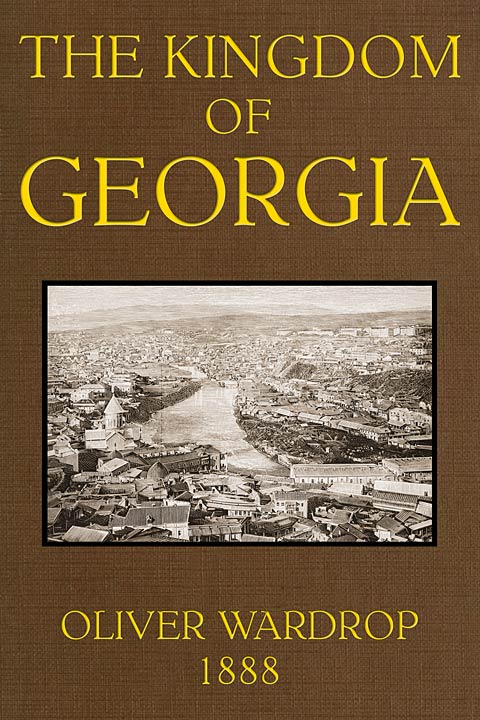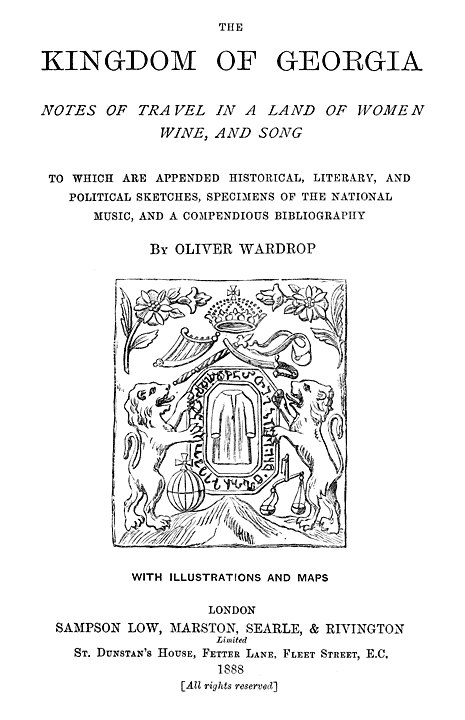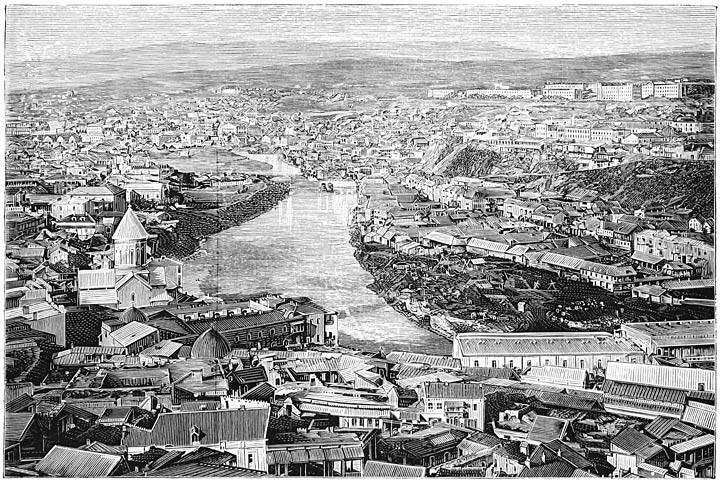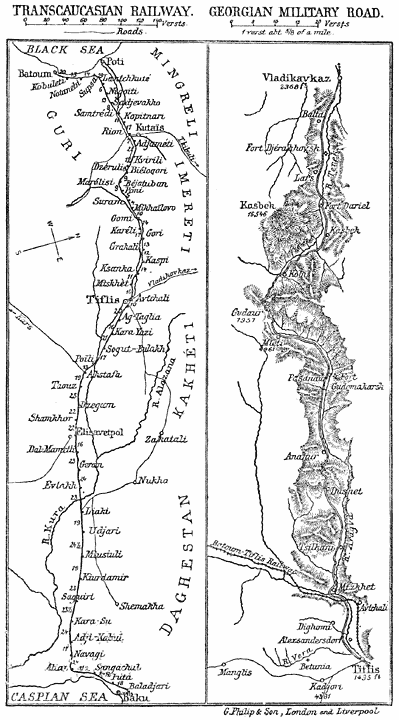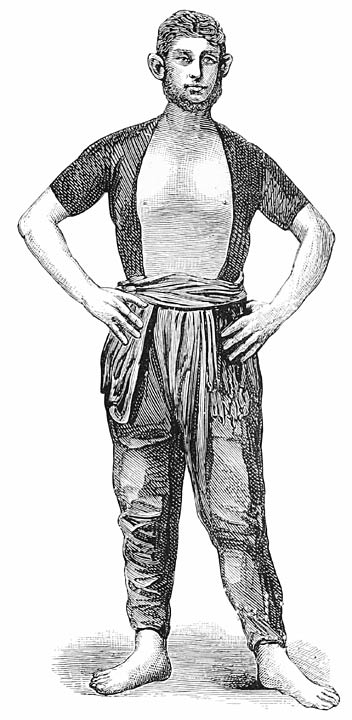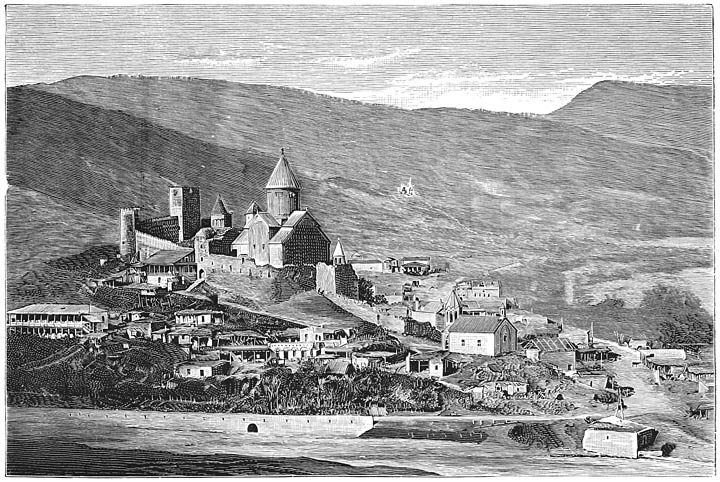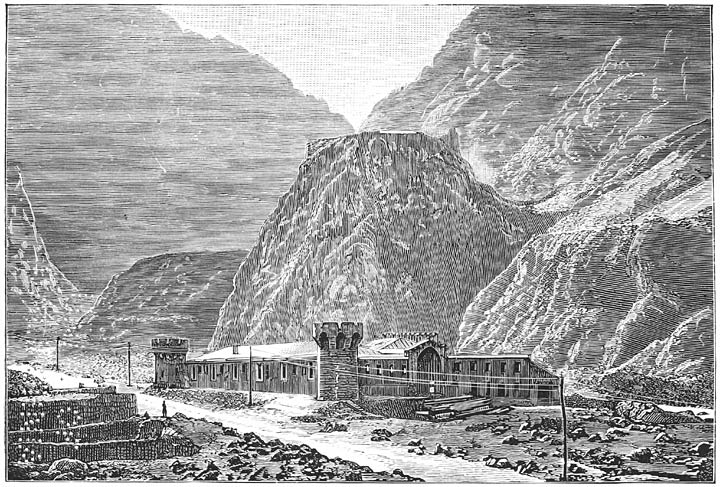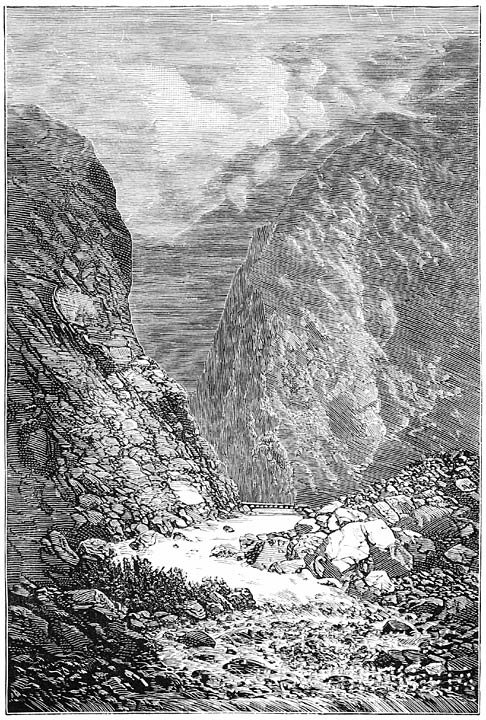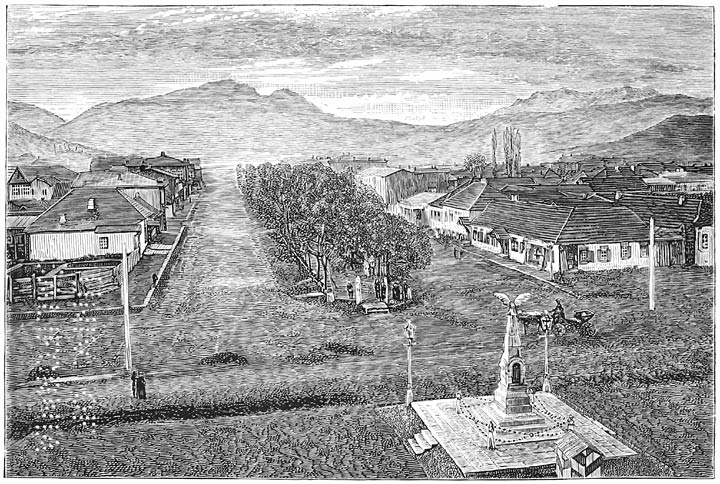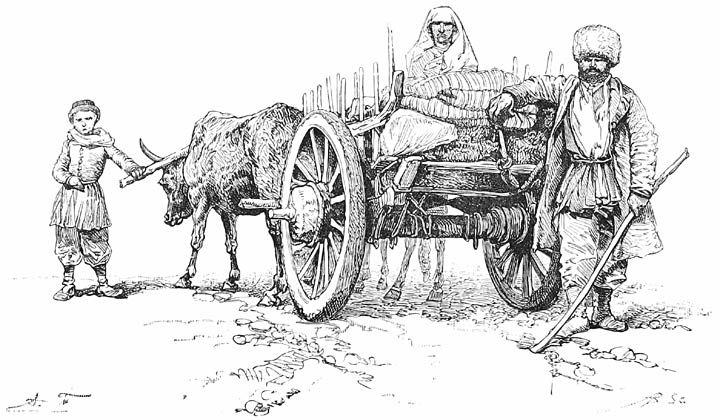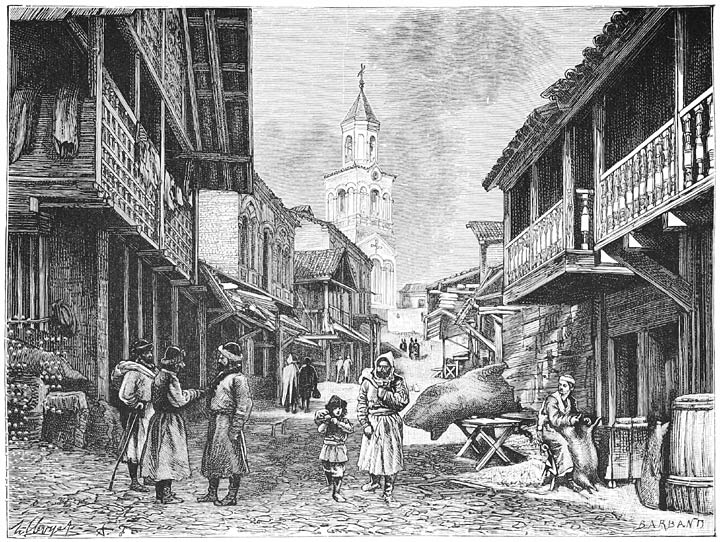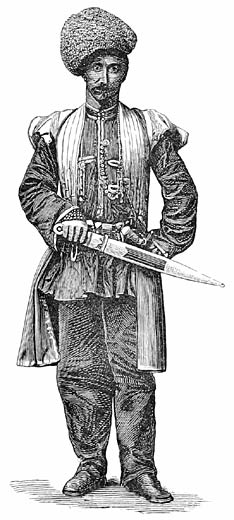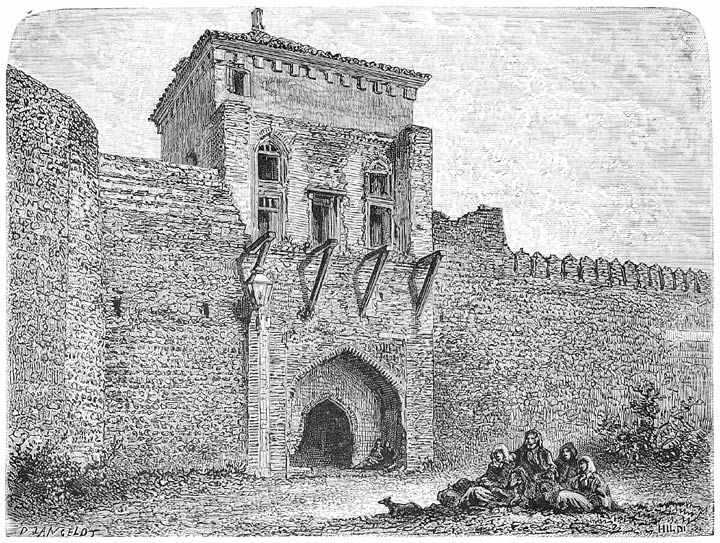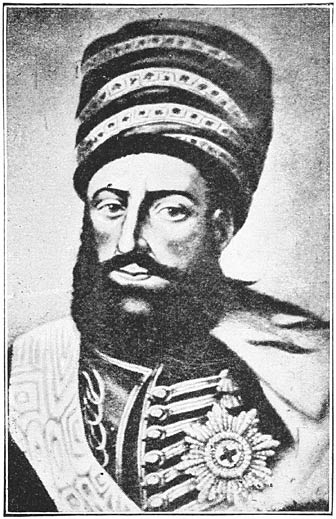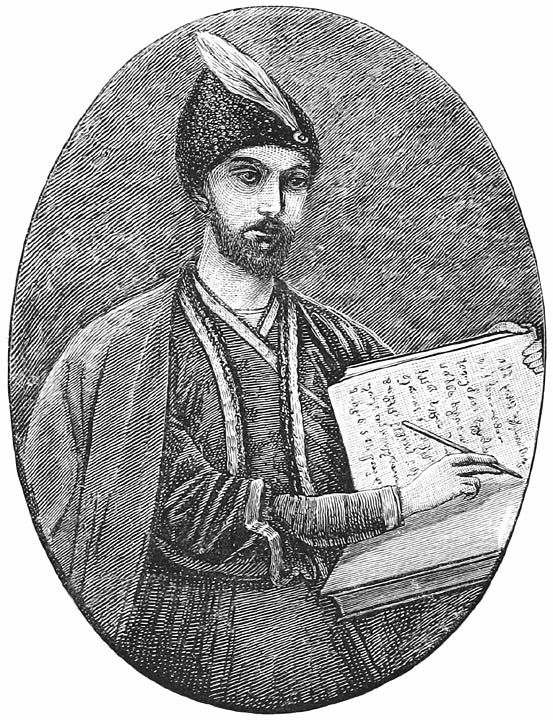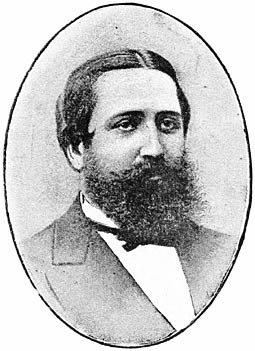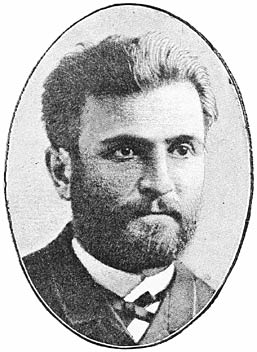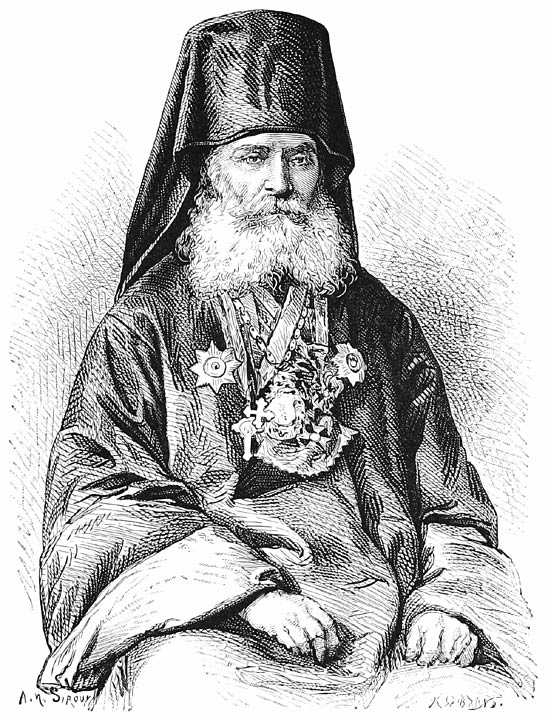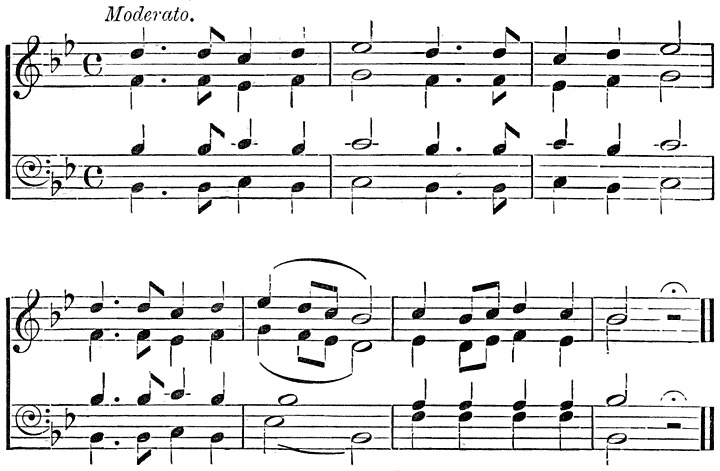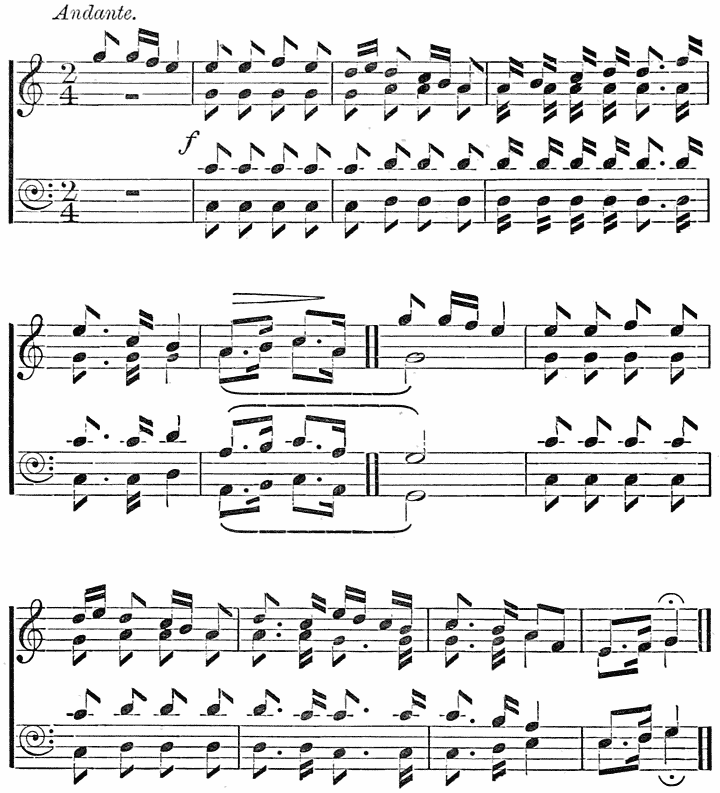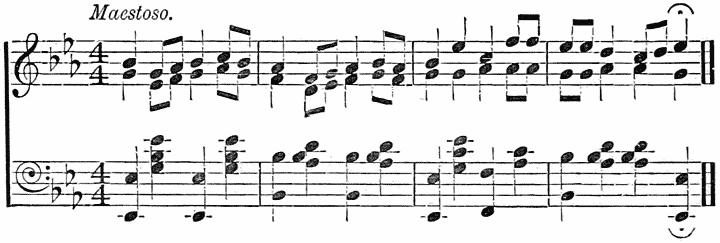A Catalogue of American and Foreign Books
Published or Imported by Messrs. Sampson Low &
Co. can be had on application.
St. Dunstan’s House, Fetter Lane, Fleet Street,
London, September, 1888.
A Selection from the List of Books
PUBLISHED BY
SAMPSON LOW, MARSTON, SEARLE, & RIVINGTON.
LIMITED.
ALPHABETICAL LIST.
Abbott (C. C.) Poaetquissings Chronicle.
10s. 6d.
—— Waste Land Wanderings. Crown 8vo,
7s. 6d.
Abney (W. de W.) and Cunningham.
Pioneers of the Alps. With photogravure portraits of guides. Imp.
8vo, gilt top, 21s.
Adam (G. Mercer) and Wetherald. An
Algonquin Maiden. Crown 8vo, 5s.
Adams (C. K.) Manual of Historical
Literature. Cr. 8vo, 12s. 6d.
Agassiz (A.) Three Cruises of the
Blake. Illustrated. 2 vols., 8vo, 42s.
Alcott. Works of the late Miss Louisa May
Alcott:—
- Eight Cousins. Illustrated, 2s.; cloth gilt, 3s.
6d.
- Jack and Jill. Illustrated, 2s.; cloth gilt, 3s.
6d.
- Jo’s Boys. 5s.
- Jimmy’s Cruise in the Pinafore, &c. Illustrated, cloth,
2s.; gilt edges, 3s. 6d.
- Little Men. Double vol., 2s.; cloth, gilt edges, 3s.
6d.
-
| Little Women, 1s. |
 |
1 vol.,
cloth, 2s.; larger ed., gilt edges, 3s. 6d. |
| Little Women Wedded, 1s. |
- Old-fashioned Girl. 2s.; cloth, gilt edges, 3s.
6d.
- Rose in Bloom. 2s.; cloth gilt, 3s. 6d.
- Silver Pitchers. Cloth, gilt edges, 3s. 6d.
- Under the Lilacs. Illustrated, 2s.; cloth gilt,
5s.
-
| Work: a Story of Experience,
1s. |
 |
1 vol.,
cloth, gilt edges 3s. 6d. |
| —— Its Sequel,
“Beginning Again.” 1s. |
Alden (W. L.) Adventures of Jimmy
Brown, written by himself. Illustrated. Small crown 8vo, cloth,
2s.
Aldrich (T. B.) Friar Jerome’s
Beautiful Book, &c. 3s. 6d.
Alford (Lady Marian) Needlework as
Art. With over 100 Woodcuts, Photogravures, &c. Royal 8vo,
21s.; large paper, 84s.
Amateur Angler’s Days in Dove Dale: Three
Weeks’ Holiday in 1884. By E. M. 1s. 6d.;
boards, 1s.; large paper, 5s. [206]
Andersen. Fairy Tales. An entirely new
Translation. With over 500 Illustrations by Scandinavian Artists. Small
4to, 6s.
Anderson (W.) Pictorial Arts of
Japan. With 80 full-page and other Plates, 16 of them in Colours.
Large imp. 4to, £8 8s. (in four folio parts, £2
2s. each); Artists’ Proofs, £12 12s.
Angler’s Strange Experiences (An). By Cotswold Isys. With numerous Illustrations, 4to, 5s.
New Edition, 3s. 6d.
Angling. See Amateur, “British,”
“Cutcliffe,” “Fennell,” “Halford,”
“Hamilton,” “Martin,” “Orvis,”
“Pennell,” “Pritt,” “Senior,”
“Stevens,” “Theakston,” “Walton,”
“Wells,” and “Willis-Bund.”
Annals of the Life of Shakespeare, from the most
recent authorities. Fancy boards, 2s.
Annesley (C.) Standard Opera Glass.
Detailed Plots of 80 Operas. Small 8vo, sewed, 1s.
6d.
Antipodean Notes, collected on a Nine Months’
Tour round the World. By Wanderer, Author of “Fair
Diana.” Crown 8vo, 7s. 6d.
Appleton. European Guide. 2 Parts, 8vo,
10s. each.
Armytage (Hon. Mrs.) Wars of
Victoria’s Reign. 5s.
Art Education. See “Biographies,”
“D’Anvers,” “Illustrated Text Books,”
“Mollett’s Dictionary.”
Artistic Japan. Illustrated with Coloured Plates.
Monthly. Royal 4to, 2s.
Attwell (Prof.) The Italian
Masters. Crown 8vo, 3s. 6d.
Audsley (G. A.) Handbook of the
Organ. Top edge gilt, 42s.; large paper, 84s.
—— Ornamental Arts of Japan. 90
Plates, 74 in Colours and Gold, with General and Descriptive Text. 2
vols., folio, £15 15s.; in specially designed leather,
£23 2s.
—— The Art of Chromo-Lithography.
Coloured Plates and Text. Folio, 63s.
—— and Tomkinson. Ivory and Wood
Carvings of Japan. 84s. Artists’ proofs (100),
168s.
Auerbach (B.) Brigitta. (B.
Tauchnitz Collection.) 2s.
—— On the Heights. 3 vols.,
6s.
—— Spinoza. 2 vols., 18mo,
4s.
Baddeley (S.) Tchay and Chianti.
Small 8vo, 5s.
Baldwin (James) Story of Siegfried.
6s.
—— Story of the Golden Age.
Illustrated by Howard Pyle. Crown 8vo,
6s. [207]
Baldwin (James) Story of Roland. Crown 8vo,
6s.
Bamford (A. J.) Turbans and Tails. Sketches in
the Unromantic East. Crown 8vo, 7s. 6d.
Barlow (Alfred) Weaving by Hand and by Power.
With several hundred Illustrations. Third Edition, royal 8vo. £l
5s.
Barlow (P. W.) Kaipara, Experiences of a Settler in
N. New Zealand. Illust., crown 8vo, 6s.
Barrow (J.) Mountain Ascents in Cumberland and
Westmoreland. Crown 8vo, 7s. 6d.; new edition,
5s.
Bassett (F. S.) Legends and Superstitions of the
Sea. 7s. 6d.
THE BAYARD SERIES.
Edited by the late J. Hain
Friswell.
Comprising Pleasure Books of Literature produced in the
Choicest Style.
“We can hardly imagine better books for boys
to read or for men to ponder over.”—Times.
Price 2s. 6d. each Volume, complete in
itself, flexible cloth extra, gilt edges, with silk Headbands and
Registers.
- The Story of the Chevalier Bayard.
- Joinville’s St. Louis of France.
- The Essays of Abraham Cowley.
- Abdallah. By Edouard Laboullaye.
- Napoleon, Table-Talk and Opinions.
- Words of Wellington.
- Johnson’s Rasselas. With Notes.
- Hazlitt’s Round Table.
- The Religio Medici, Hydriotaphia, &c. By Sir Thomas Browne,
Knt.
- Coleridge’s Christabel, &c. With Preface by Algernon C.
Swinburne.
|
- Ballad Poetry of the Affections. By Robert Buchanan.
- Lord Chesterfield’s Letters, Sentences, and Maxims. With
Essay by Sainte-Beuve.
- The King and the Commons. Cavalier and Puritan Songs.
- Vathek. By William Beckford.
- Essays in Mosaic. By Ballantyne.
- My Uncle Toby; his Story and his Friends. By P. Fitzgerald.
- Reflections of Rochefoucauld.
- Socrates: Memoirs for English Readers from Xenophon’s
Memorabilia. By Edw. Levien.
- Prince Albert’s Golden Precepts.
|
A Case containing 12 Volumes, price 31s.
6d.; or the Case separately, price 3s. 6d.
Baynes (Canon) Hymns and other Verses. Crown 8vo,
sewed, 1s.; cloth, 1s. 6d.
Beaugrand (C.) Walks Abroad of Two Young
Naturalists. By D. Sharp. Illust., 8vo,
7s. 6d.
Beecher (H. W.) Authentic Biography, and Diary.
[Preparing
Behnke and Browne. Child’s Voice: its Treatment
with regard to After Development. Small 8vo, 3s.
6d.
Beyschlag. Female Costume Figures of various
Centuries. 12 reproductions of pastel designs in portfolio,
imperial. 21s.
Bickersteth (Bishop E. H.) Clergyman in his Home.
1s.
—— —— Evangelical
Churchmanship. 1s. [208]
Bickersteth (Bishop E. H.) From Year to
Year: Original Poetical Pieces. Small post 8vo, 3s.
6d.; roan, 6s. and 5s.; calf or morocco,
10s. 6d.
—— The Master’s Home-Call. 20th
Thous. 32mo, cloth gilt, 1s.
—— The Master’s Will. A Funeral
Sermon preached on the Death of Mrs. S. Gurney Buxton. Sewn,
6d.; cloth gilt, 1s.
—— The Reef, and other Parables.
Crown 8vo, 2s. 6d.
—— Shadow of the Rock. Select
Religious Poetry. 2s. 6d.
—— The Shadowed Home and the Light
Beyond. 5s.
Bigelow (John) France and the
Confederate Navy. An International Episode. 7s.
6d.
Biographies of the Great Artists
(Illustrated). Crown 8vo, emblematical binding, 3s.
6d. per volume, except where the price is given.
- Claude le Lorrain, by Owen J. Dullea.
- Correggio, by M. E. Heaton. 2s. 6d.
- Delia Robbia and Cellini. 2s. 6d.
- Albrecht Dürer, by R. F. Heath.
- Figure Painters of Holland.
- Fra Angelico, Masaccio, and Botticelli.
- Fra Bartolommeo, Albertinelli, and Andrea del Sarto.
- Gainsborough and Constable.
- Ghiberti and Donatello. 2s. 6d.
- Giotto, by Harry Quilter.
- Hans Holbein, by Joseph Cundall.
- Hogarth, by Austin Dobson.
- Landseer, by F. G. Stevens.
- Lawrence and Romney, by Lord Ronald Gower. 2s.
6d.
- Leonardo da Vinci.
- Little Masters of Germany, by W. B. Scott.
- Mantegna and Francia.
|
- Meissonier, by J. W. Mollett. 2s. 6d.
- Michelangelo Buonarotti, by Clément.
- Murillo, by Ellen E. Minor. 2s. 6d.
- Overbeck, by J. B. Atkinson.
- Raphael, by N. D’Anvers.
- Rembrandt, by J. W. Mollett.
- Reynolds, by F. S. Pulling.
- Rubens, by C. W. Kett.
- Tintoretto, by W. R. Osler.
- Titian, by R. F. Heath.
- Turner, by Cosmo Monkhouse.
- Vandyck and Hals, by P. R. Head.
- Velasquez, by E. Stowe.
- Vernet and Delaroche, by J. Rees.
- Watteau, by J. W. Mollett. 2s. 6d.
- Wilkie, by J. W. Mollett.
|
Bird (F. J.) American Practical
Dyer’s Companion. 8vo, 42s.
—— (H. E.) Chess Practice.
8vo, 2s. 6d.
Black (Robert) Horse Racing in France:
a History. 8vo, 14s.
Black (Wm.) Novels. See
“Low’s Standard Library.”
—— Strange Adventures of a
House-Boat. 3 vols., 31s. 6d.
—— In Far Lochaber. 3 vols., crown
8vo., 31s. 6d.
Blackburn (Charles F.) Hints on
Catalogue Titles and Index Entries, with a Vocabulary of Terms and
Abbreviations, chiefly from Foreign Catalogues. Royal 8vo,
14s.
Blackburn (Henry) Breton Folk. With
171 Illust. by Randolph Caldecott. Imperial
8vo, gilt edges, 21s.; plainer binding, 10s.
6d.
—— Pyrenees. Illustrated by
Gustave Doré, corrected to 1881. Crown
8vo, 7s. 6d. See also Caldecott.
[209]
Blackmore (R. D.) Lorna Doone. Edition
de luxe. Crown 4to, very numerous Illustrations, cloth, gilt edges,
31s. 6d.; parchment, uncut, top gilt, 35s.; new
issue, plainer, 21s.; small post 8vo, 6s.
—— Novels. See “Low’s
Standard Library.”
—— Springhaven. Illust. by
Parsons and Barnard.
Sq. 8vo, 12s.
Blaikie (William) How to get Strong and
how to Stay so. Rational, Physical, Gymnastic, &c., Exercises.
Illust., sm. post 8vo, 5s.
—— Sound Bodies for our Boys and
Girls. 16mo, 2s. 6d.
Bonwick. British Colonies. Asia,
1s.; Africa, 1s.; America, 1s.; Australasia,
1s. One vol., cloth, 5s.
Bosanquet (Rev. C.) Blossoms from the
King’s Garden: Sermons for Children. 2nd Edition, small post
8vo, cloth extra, 6s.
—— Jehoshaphat; or, Sunlight and
Clouds. 1s.
Boussenard (L.) Crusoes of Guiana.
Gilt, 2s. 6d.; gilt ed., 3s. 6d.
—— Gold-seekers. Sequel to the above.
Illust. 16mo, 5s.
Boyesen (F.) Story of Norway.
Illustrated, sm. 8vo, 7s. 6d.
Boyesen (H. H.) Modern Vikings: Stories
of Life and Sport in Norseland. Cr. 8vo, 6s.
Boy’s Froissart. King Arthur.
Knightly Legends of Wales. Percy. See Lanier.
Bradshaw (J.) New Zealand of
To-day, 1884–87. 8vo.
Brannt (W. T.) Animal and Vegetable
Fats and Oils, 244 Illust., 8vo, 35s.
—— Manufacture of Soap and Candles, with
many Formulas. Illust., 8vo, 35s.
—— Metallic Alloys. Chiefly from the
German of Krupp and Wilberger. Crown 8vo, 12s.
6d.
Bright (John) Public Letters. Crown
8vo, 7s. 6d.
Brisse (Baron) Ménus (366).
A ménu, in French and English, for every Day in
the Year. 2nd Edition. Crown 8vo, 5s.
British Fisheries Directory. Small 8vo,
2s. 6d.
Brittany. See Blackburn.
Browne (G. Lennox) Voice Use and
Stimulants. Sm. 8vo, 3s. 6d.
—— and Behnke (Emil) Voice,
Song, and Speech. N ed., 5s.
Bryant (W. C.) and Gay (S.
H.) History of the United States. 4 vols., royal 8vo,
profusely Illustrated, 60s.
Bryce (Rev. Professor) Manitoba.
Illust. Crown 8vo, 7s. 6d.
—— Short History of the Canadian
People. 7s. 6d.
Burnaby (Capt.) On Horseback through
Asia Minor. 2 vols., 8vo, 38s. Cheaper Edition, 1 vol.,
crown 8vo, 10s. 6d. [210]
Burnaby (Mrs. F.) High Alps in Winter;
or, Mountaineering in Search of Health. With Illustrations,
&c., 14s. See also Main.
Burnley (J.) History of Wool and
Woolcombing. Illust. 8vo, 21s.
Burton (Sir R. F.) Early, Public, and
Private Life. Edited by F. Hitchman. 2
vols., 8vo, 36s.
Butler (Sir W. F.) Campaign of the
Cataracts. Illust., 8vo, 18s.
—— Invasion of England, told twenty years
after. 2s. 6d.
—— Red Cloud; or, the Solitary Sioux.
Imperial 16mo, numerous illustrations, gilt edges, 3s.
6d.; plainer binding, 2s. 6d.
—— The Great Lone Land; Red River
Expedition. 7s. 6d.
—— The Wild North Land; the Story of a
Winter Journey with Dogs across Northern North America. 8vo,
18s. Cr. 8vo, 7s. 6d.
Cable (G. W.)
Bonaventure: A Prose Pastoral of Acadian Louisiana. Sm. post
8vo, 5s.
Cadogan (Lady A.) Illustrated Games of
Patience. Twenty-four Diagrams in Colours, with Text. Fcap. 4to,
12s. 6d.
—— New Games of Patience. Coloured
Diagrams, 4to, 12s. 6d.
Caldecott (Randolph) Memoir. By
Henry Blackburn. With 170 Examples of the
Artist’s Work. 14s.; large paper, 21s.
California. See Nordhoff.
Callan (H.) Wanderings on Wheel and on
Foot. Cr. 8vo, 1s. 6d.
Campbell (Lady Colin) Book of the
Running Brook: and of Still Waters. 5s.
Canadian People: Short History. Crown 8vo,
7s. 6d.
Carleton (Will) Farm Ballads, Farm
Festivals, and Farm Legends. Paper boards, 1s. each; 1 vol.,
small post 8vo, 3s. 6d.
—— City Ballads. Illustrated,
12s. 6d. New Ed. (Rose Library), 16mo, 1s.
Carnegie (A.) American Four-in-Hand in
Britain. Small 4to, Illustrated, 10s. 6d. Popular
Edition, paper, 1s.
—— Round the World. 8vo, 10s.
6d.
—— Triumphant Democracy. 6s.;
also 1s. 6d. and 1s.
Chairman’s Handbook. By R.
F. D. Palgrave. 5th Edit., 2s.
Changed Cross, &c. Religious Poems. 16mo,
2s. 6d.; calf, 6s.
Chaplin (J. G.) Three Principles of
Book-keeping. 2s. 6d.
Charities of London. See Low’s.
Chattock (R. S.) Practical Notes on
Etching. New Ed. 8vo, 10s. 6d.
Chess. See Bird
(H. E.). [211]
Children’s Praises. Hymns for Sunday-Schools
and Services. Compiled by Louisa H. H.
Tristram. 4d.
Choice Editions of Choice Books. 2s.
6d. each. Illustrated by C. W. Cope,
R.A., T. Creswick, R.A., E.
Duncan, Birket Foster, J. C. Horsley, A.R.A., G. Hicks,
R. Redgrave, R.A., C.
Stonehouse, F. Tayler, G. Thomas, H. J. Townshend,
E. H. Wehnert, Harrison
Weir, &c.
- Bloomfield’s Farmer’s Boy.
- Campbell’s Pleasures of Hope.
- Coleridge’s Ancient Mariner.
- Goldsmith’s Deserted Village.
- Goldsmith’s Vicar of Wakefield.
- Gray’s Elegy in a Churchyard.
- Keat’s Eve of St. Agnes.
|
- Milton’s L’Allegro.
- Poetry of Nature. Harrison Weir.
- Rogers’ (Sam.) Pleasures of Memory.
- Shakespeare’s Songs and Sonnets.
- Tennyson’s May Queen.
- Elizabethan Poets.
- Wordsworth’s Pastoral Poems.
|
“Such works are a glorious beatification
for a poet.”—Athenæum.
Chreiman (Miss) Physical Culture of Women. A Lecture
at the Parkes Museum. Small 8vo, 1s.
Christ in Song. By Philip
Schaff. New Ed., gilt edges, 6s.
Chromo-Lithography. See Audsley.
Cochran (W.) Pen and Pencil in Asia Minor.
Illust., 8vo, 21s.
Collingwood (Harry) Under the Meteor Flag. The
Log of a Midshipman. Illustrated, small post 8vo, gilt, 3s.
6d.; plainer, 2s. 6d.
—— Voyage of the
“Aurora.” Gilt, 3s. 6d.; plainer,
2s. 6d.
Cook (Dutton) Book of the Play. New Edition. 1
vol., 3s. 6d.
—— On the Stage: Studies. 2 vols.,
8vo, cloth, 24s.
Cowen (Jos., M.P.) Life and Speeches. 8vo,
14s.
Cowper (W.) Poetical Works: A Concordance. Roy.
8vo, 21s.
Cozzens (F.) American Yachts. 27 Plates, 22
× 28 inches. Proofs, £21; Artist’s Proofs, £31
10s.
Crew (B. J.) Practical Treatise on Petroleum.
Illust., 8vo, 28s.
Crouch (A. P.) On a Surf-bound Coast. Crown 8vo,
7s. 6d.
Crown Prince of Germany: a Diary. 2s.
6d.
Cudworth (W.) Life and Correspondence of Abraham
Sharp. Illustrated from Drawings. (To Subscribers, 21s.)
26s.
Cumberland (Stuart) Thought Reader’s
Thoughts. Cr. 8vo., 10s. 6d.
—— Queen’s Highway from Ocean to
Ocean. Ill., 8vo, 18s.; new ed., 7s. 6d.
Cundall (Joseph) Annals of the Life and Work of
Shakespeare. With a List of Early Editions. 3s. 6d.;
large paper, 5s.; also 2s.
—— Remarkable Bindings in the British
Museum.
Curtis (W. E.) Capitals of Spanish America. Illust., roy. 8vo.
Cushing (W.) Initials and Pseudonyms. Large 8vo,
25s.; second series, large 8vo, 21s. [212]
Custer (Eliz. B.) Tenting on the Plains; Gen. Custer
in Kansas and Texas. Royal 8vo, 18s.
Cutcliffe (H. C.) Trout Fishing in Rapid Streams.
Cr. 8vo, 3s. 6d.
Daly (Mrs. D.) Digging, Squatting, and Pioneering
in in Northern South Australia. 8vo, 12s.
D’Anvers. Elementary History of Art.
New ed., 360 illus., cr. 8vo, 2 vols. (5s. each), gilt,
10s. 6d.
—— Elementary History of Music. Crown
8vo, 2s. 6d.
Davidson (H. C.) Old Adam; Tale of an Army
Crammer. 3 vols. crown 8vo, 31s. 6d.
Davis (Clement) Modern Whist. 4s.
Davis (C. T.) Bricks, Tiles, Terra-Cotta, &c.
Ill. 8vo, 25s.
—— Manufacture of Leather. With many
Illustrations. 52s. 6d.
—— Manufacture of Paper.
28s.
Davis (G. B.) Outlines of International Law. 8vo.
10s. 6d.
Dawidowsky. Glue, Gelatine, Isinglass, Cements,
&c. 8vo, 12s. 6d.
Day of My Life at Eton. By an Eton Boy. 16mo. 2s. 6d.
Day’s Collacon: an Encyclopædia of Prose
Quotations. Imperial 8vo, cloth, 31s. 6d.
De Leon (E.) Under the Stars and under the
Crescent. N. ed., 6s.
Dethroning Shakspere. Letters to the Daily
Telegraph; and Editorial Papers. Crown 8vo, 2s.
6d.
Dictionary. See Tolhausen, “Technological.”
Dogs in Disease. By Ashmont. Crown 8vo, 7s. 6d.
Donnelly (Ignatius) Atlantis; or, the Antediluvian
World. 7th Edition, crown 8vo, 12s. 6d.
—— Ragnarok: The Age of Fire and
Gravel. Illustrated, crown 8vo, 12s. 6d.
—— The Great Cryptogram: Francis
Bacon’s Cipher in the so-called Shakspere Plays. With
facsimiles. 2 vols., 30s.
Doré (Gustave) Life and Reminiscences. By
Blanche Roosevelt. Illust. from the
Artist’s Drawings. Medium 8vo, 24s.
Dougall (James Dalziel) Shooting: its Appliances,
Practice, and Purpose. New Edition, revised with additions. Crown
8vo, 7s. 6d.
“The book is admirable in every way.... We
wish it every success.”—Globe.
“A very complete treatise.... Likely to take high
rank as an authority on shooting.”—Daily News.
Duprè (Giovanni). By Frieze. With Dialogues on Art. 7s. 6d.
Edmonds (C.) Poetry of the Anti-Jacobin. With
Additional matter. New ed. Illust., crown 8vo.
Educational List and Directory for 1887–88.
5s. [213]
Educational Works published in Great Britain. A
Classified Catalogue. Third Edition, 8vo, cloth extra, 6s.
Edwards (E.) American Steam Engineer. Illust.,
12mo, 12s. 6d.
Eight Months on the Argentine Gran Chaco. 8vo,
8s. 6d.
Elliott (H. W.) An Arctic Province: Alaska and the
Seal Islands. Illustrated from Drawings; also with Maps.
16s.
Emerson (Dr. P. H.) Pictures of East Anglian
Life. Ordinary ed., 105s.; édit. de luxe, 17 ×
13½, vellum, morocco back, 147s.
—— Naturalistic Photography for Art
Students. Crown 8vo.
—— and Goodall. Life and Landscape
on the Norfolk Broads. Plates 12 × 8 inches, 126s.;
large paper, 210s.
English Catalogue of Books. Vol. III.,
1872–1880. Royal 8vo, half-morocco, 42s. See also
“Index.”
English Etchings. Published Quarterly. 3s.
6d. Vol. VI., 25s.
English Philosophers. Edited by E. B. Ivan Müller, M.A. Crown 8vo volumes of 180 or
200 pp., price 3s. 6d. each.
- Francis Bacon, by Thomas Fowler.
- Hamilton, by W. H. S. Monck.
- Hartley and James Mill.
|
- Shaftesbury and Hutcheson.
- Adam Smith, by J. A. Farrer.
|
Esmarch (F.) Handbook of Surgery. Translation
from the last German Edition. With 647 new Illustrations. 8vo, leather,
24s.
Etching. See Chattock,
and English Etchings.
Etchings (Modern) of Celebrated Paintings. 4to,
31s. 6d.
Evans (E. A.) Songs of the Birds. Analogies of
Spiritual Life. New Ed. Illust., 6s.
Evelyn. Life of Mrs. Godolphin. By William Harcourt, of Nuneham. Steel Portrait. Extra
binding, gilt top, 7s. 6d.
Farini (G. A.) Through the Kalahari Desert. 8vo,
21s.
Farm Ballads, Festivals, and Legends. See
Carleton.
Fawcett (Edgar) A Gentleman of Leisure.
1s.
Fenn (G. Manville) Off to the Wilds: A Story for
Boys. Profusely Illustrated. Crown 8vo, gilt edges, 3s.
6d.; plainer, 2s. 6d.
—— Silver Cañon. Illust., gilt
ed., 3s. 6d.; plainer, 2s. 6d.
Fennell (Greville) Book of the Roach. New
Edition, 12mo, 2s.
Ferns. See Heath.
Field (H. M.) Greek Islands and Turkey after the
War. 8s. 6d.
Field (Mrs. Horace) Anchorage. 2 vols., crown
8vo, 12s.
Fields (J. T.) Yesterdays with Authors. New Ed.,
8vo, 10s. 6d.
Fitzgerald (P.) Book Fancier. Cr. 8vo.
5s.; large pap. 12s. 6d. [214]
Fleming (Sandford) England and Canada: a Tour.
Cr. 8vo, 6s.
Florence. See Yriarte.
Folkard (R., Jun.) Plant Lore, Legends, and
Lyrics. 8vo, 16s.
Forbes (H. O.) Naturalist in the Eastern
Archipelago. 8vo. 21s.
Foreign Countries and British Colonies. Cr. 8vo,
3s. 6d. each.
- Australia, by J. F. Vesey Fitzgerald.
- Austria, by D. Kay, F.R.G.S.
- Denmark and Iceland, by E. C. Otté.
- Egypt, by S. Lane Poole, B.A.
- France, by Miss M. Roberts.
- Germany, by S. Baring-Gould.
- Greece, by L. Sergeant, B.A.
|
- Japan, by S. Mossman.
- Peru, by Clements R. Markham.
- Russia, by W. R. Morfill, M.A.
- Spain, by Rev. Wentworth Webster.
- Sweden and Norway, by Woods.
- West Indies, by C. H. Eden, F.R.G.S.
|
Foreign Etchings. From Paintings by Rembrandt,
&c., 63s.; india proofs, 147s.
Fortunes made in Business. Vols. I., II., III.
16s. each.
Frampton (Mary) Journal, Letters, and Anecdotes.
8vo, 14s.
Franc (Maud Jeanne). Small post 8vo, uniform,
gilt edges:—
- Emily’s Choice. 5s.
- Hall’s Vineyard. 4s.
- John’s Wife: A Story of Life in South Australia.
4s.
- Marian; or, The Light of Some One’s Home. 5s.
- Silken Cords and Iron Fetters. 4s.
- Into the Light. 4s.
- Vermont Vale. 5s.
|
- Minnie’s Mission. 4s.
- Little Mercy. 4s.
- Beatrice Melton’s Discipline. 4s.
- No Longer a Child. 4s.
- Golden Gifts. 4s.
- Two Sides to Every Question. 4s.
- Master of Ralston. 4s.
|
Also a Cheap Edition, in cloth extra,
2s. 6d. each.
Frank’s Ranche; or, My Holiday in the
Rockies. A Contribution to the Inquiry into What we are to Do with
our Boys. 5s.
Freeman (J.) Lights and Shadows of Melbourne
Life. Cr. 8vo. 6s.
French. See Julien and
Porcher.
Fresh Woods and Pastures New. By the Author of
“An Amateur Angler’s Days.” 1s. 6d.;
large paper, 5s.; new ed., 1s.
Froissart. See Lanier.
Fuller (Edward) Fellow Travellers. 3s.
6d.
—— Dramatic Year 1887–88 in the
United States. With the London Season, by W.
Archer. Crown 8vo.
Gane (D. N.) New South Wales and Victoria in
1885. 5s.
Gasparin (Countess A. de) Sunny Fields and Shady
Woods. 6s.
Geary (Grattan) Burma after the Conquest.
7s. 6d.
Gentle Life (Queen Edition). 2 vols. in 1, small
4to, 6s. [215]
THE GENTLE LIFE SERIES.
Price 6s. each; or in calf extra, price
10s. 6d.; Smaller Edition, cloth extra, 2s.
6d., except where price is named.
The Gentle Life. Essays in aid of the Formation
of Character.
About in the World. Essays by Author of
“The Gentle Life.”
Like unto Christ. New Translation of Thomas
à Kempis.
Familiar Words. A Quotation Handbook.
6s.
Essays by Montaigne. Edited by the Author of
“The Gentle Life.”
The Gentle Life. 2nd Series.
The Silent Hour: Essays, Original and
Selected.
Half-Length Portraits. Short Studies of Notable
Persons. By J. Hain Friswell.
Essays on English Writers, for Students in
English Literature.
Other People’s Windows. By J. Hain Friswell. 6s.
A Man’s Thoughts. By J.
Hain Friswell.
The Countess of Pembroke’s Arcadia. By
Sir Philip Sidney. 6s.
Germany. By S.
Baring-Gould. Crown 8vo, 3s. 6d.
Gibbon (C.) Beyond Compare: a
Story. 3 vols., cr. 8vo, 31s. 6d.
—— Yarmouth Coast.
Gisborne (W.) New Zealand Rulers and
Statesmen. With Portraits. Crown 8vo, 7s. 6d.
Goldsmith. She Stoops to Conquer. Introduction by
Austin Dobson; the designs by E. A. Abbey. Imperial 4to, 48s.
Goode (G. Brown) American Fishes. A
Popular Treatise. Royal 8vo, 24s.
Gordon (J. E. H., B.A. Cantab.) Four
Lectures on Electric Induction at the Royal Institution,
1878–9. Illust., square 16mo, 3s.
—— Electric Lighting. Illustrated,
8vo, 18s.
—— Physical Treatise on Electricity and
Magnetism. 2nd Edition, enlarged, with coloured, full-page,
&c., Illust. 2 vols., 8vo, 42s.
—— Electricity for Schools.
Illustrated. Crown 8vo, 5s.
Gouffé (Jules) Royal Cookery
Book. New Edition, with plates in colours, Woodcuts. &c., 8vo,
gilt edges. 42s.
—— Domestic Edition, half-bound, 10s.
6d.
Grant (General, U.S.) Personal
Memoirs. 2 vols., 8vo, 28s. Illustrations, Maps, &c. 2
vols., 8vo, 28s.
Great Artists. See “Biographies.”
[216]
Great Musicians. Edited by F.
Hueffer. A Series of Biographies, crown 8vo, 3s.
each:—
- Bach.
- English Church Composers. By Barrett.
- Handel.
- Haydn.
- Mendelssohn.
- Mozart.
|
- Purcell.
- Rossini.
- Schubert.
- Schumann.
- Richard Wagner.
- Weber.
|
Groves (J. Percy) Charmouth Grange.
Gilt, 5s.; plainer, 2s. 6d.
Guizot’s History of France. Translated by
R. Black. In 8 vols., super-royal 8vo, cloth
extra, gilt, each 24s. In cheaper binding, 8 vols., at
10s. 6d. each.
“It supplies a want which has long been
felt, and ought to be in the hands of all students of
history.”—Times.
—— —— ——
—— Masson’s School Edition. Abridged from the
Translation by Robert Black, with Chronological Index, Historical and
Genealogical Tables, &c. By Professor Gustave
Masson, B.A. With Portraits, Illustrations, &c. 1 vol., 8vo,
600 pp., 5s.
Guyon (Mde.) Life. By Upham. 6th Edition, crown 8vo, 6s.
Halford (F. M.)
Floating Flies, and how to Dress them. Coloured plates. 8vo,
15s.; large paper, 30s.
—— Dry Fly-Fishing in Theory and
Practice. Col. Plates.
Hall (W. W.) How to Live Long; or, 1408
Maxims. 2s.
Hamilton (E.) Recollections of
Fly-fishing for Salmon, Trout, and Grayling. With their Habits,
Haunts, and History. Illust., 6s.; large paper, 10s.
6d.
Hands (T.) Numerical Exercises in
Chemistry. Cr. 8vo, 2s. 6d. and 2s.; Answers
separately, 6d.
Hardy (Thomas). See Low’s Standard Novels.
Hare (J. S. Clark) Law of
Contracts. 8vo, 26s.
Harley (T.) Southward Ho! to the State
of Georgia. 5s.
Harper’s Magazine. Published Monthly. 160
pages, fully Illustrated, 1s. Vols., half yearly, I.—XVI.,
super-royal 8vo, 8s. 6d. each.
“‘Harper’s Magazine’ is so
thickly sown with excellent illustrations that to count them would be a
work of time; not that it is a picture magazine, for the engravings
illustrate the text after the manner seen in some of our choicest
éditions de luxe.”—St.
James’s Gazette.
“It is so pretty, so big, and so cheap.... An
extraordinary shillingsworth—160 large octavo pages, with over a
score of articles, and more than three times as many
illustrations.”—Edinburgh Daily Review.
“An amazing shillingsworth ... combining choice
literature of both nations.”—Nonconformist.
Harper’s Young People. Vols. I.–IV.,
profusely Illustrated with woodcuts and coloured plates. Royal 4to,
extra binding, each 7s. 6d.; gilt edges, 8s.
Published Weekly, in wrapper, 1d.; Annual Subscription, post
free, 6s. 6d.; Monthly, in wrapper, with coloured plate,
6d.; Annual Subscription, post free, 7s. 6d.
[217]
Harrison (Mary) Skilful Cook. New
edition, crown 8vo, 5s.
Hartshorne (H.) Household Medicine,
Surgery, &c. 8vo. 21s.
Hatton (Frank) North Borneo. Map
and Illust., &c. 18s.
Hatton (Joseph) Journalistic London:
with Engravings and Portraits of Distinguished Writers of the Day.
Fcap. 4to, 12s. 6d.
—— See also Low’s Standard Novels.
Hawthorne (Nathaniel) Life. By
John R. Lowell.
Heath (Francis George) Fern
World. With Nature-printed Coloured Plates. Crown
8vo, gilt edges, 12s. 6d. Cheap Edition, 6s.
Heath (Gertrude). Tell us Why? The
Customs and Ceremonies of the Church of England explained for
Children. Cr. 8vo, 2s. 6d.
Heldmann (B.) Mutiny of the Ship
“Leander.” Gilt edges, 3s. 6d.; plainer,
2s. 6d.
Henty. Winning his Spurs. Cr. 8vo, 3s.
6d.; plainer, 2s. 6d.
—— Cornet of Horse. Cr. 8vo,
3s. 6d.; plainer, 2s. 6d.
—— Jack Archer. Illust. 3s.
6d.; plainer, 2s. 6d.
Henty (Richmond) Australiana: My Early
Life. 5s.
Herrick (Robert) Poetry. Preface by
Austin Dobson. With numerous Illustrations by
E. A. Abbey. 4to, gilt edges, 42s.
Hetley (Mrs. E.) Native Flowers of New
Zealand. Chromos from Drawings. Three Parts, to Subscribers,
63s.
Hewitt (James A.) Church History in
South Africa, 1795–1848, 12mo, 5s.
Hicks (E. S.) Our Boys: How to Enter
the Merchant Service. 5s.
—— Yachts, Boats and Canoes.
Illustrated. 8vo, 10s. 6d.
Hitchman. Public Life of the Earl of
Beaconsfield. 3s. 6d.
Hoey (Mrs. Cashel) See Low’s Standard Novels.
Hofmann. Scenes from the Life of our Saviour. 12
mounted plates, 12 × 9 inches, 21s.
Holder (C. F.) Marvels of Animal
Life. Illustrated. 8s. 6d.
—— Ivory King: Elephant and Allies.
Illustrated. 8s. 6d.
—— Living Lights: Phosphorescent Animals
and Vegetables. Illustrated. 8vo, 8s. 6d.
Holmes (O. W.) Before the Curfew, &c.
Occasional Poems. 5s.
—— Last Leaf: a Holiday Volume.
42s.
—— Mortal Antipathy, 8s.
6d.; also 2s.; paper, 1s.
—— Our Hundred Days in Europe.
6s. Large Paper, 15s.
—— Poetical Works. 2 vols., 18mo,
gilt tops, 10s. 6d.
Homer, Iliad I.-XII., done into English Verse. By
Arthur S. Way. 9s.
—— Odyssey, done into English Verse.
By A. S. Way. Fcap 4to, 7s. 6d.
[218]
Hopkins (Manley) Treatise on the
Cardinal Numbers. 2s. 6d.
Hore (Mrs.) To Lake Tanganyika in a
Bath Chair. Cr. 8vo, 7s. 6d.
Howard (Blanche W.) Tony the Maid; a
Novelette. Illust., 12mo, 3s. 6d.
Howorth (H. H.) Mammoth and the
Flood. 8vo, 18s.
Huet (C. B.) Land of Rubens. For
Visitors to Belgium. By Van Dam. Crown 8vo,
3s. 6d.
Hugo (V.) Notre Dame. With coloured
etchings and 150 engravings. 2 vols., 8vo, vellum cloth,
30s.
Hundred Greatest Men (The). 8 portfolios,
21s. each, or 4 vols., half-morocco, gilt edges, 10 guineas. New
Ed., 1 vol., royal 8vo, 21s.
Hutchinson (T.) Diary and Letters.
Vol. I., 16s.; Vol. II., 16s.
Hygiene and Public Health. Edited by A. H. Buck, M.D. Illustrated. 2 vols., royal 8vo,
42s.
Hymnal Companion to the Book of Common Prayer. By
Bishop Bickersteth. In various styles and
bindings from 1d. to 31s. 6d. Price List and
Prospectus will be forwarded on application.
Hymns and Tunes at St. Thomas’, New York.
Music by G. W. Farren. Royal 8vo,
5s.
Illustrated Text-Books of Art-Education. Edited
by Edward J. Poynter, R.A. Illustrated, and
strongly bound, 5s.
Now ready:—
- PAINTING.
- Classic and Italian. By Head.
- German, Flemish, and Dutch.
|
- French and Spanish.
- English and American.
|
- ARCHITECTURE.
- Classic and Early Christian.
|
- Gothic and Renaissance. By T. Roger
Smith.
|
- SCULPTURE.
- Antique: Egyptian and Greek.
|
- Renaissance and Modern. By Leader
Scott.
|
Inderwick (F. A.; Q.C.) Side Lights on
the Stuarts. Essays. Illustrated, 8vo.
Index to the English Catalogue, Jan., 1874, to Dec.,
1880. Royal 8vo, half-morocco, 18s.
Inglis (Hon. James; “Maori”)
Our New Zealand Cousins. Small post 8vo, 6s.
—— Tent Life in Tiger Land: Twelve Years
a Pioneer Planter. Col. plates, roy. 8vo, 18s.
Irving (Henry) Impressions of
America. 2 vols., 21s.; 1 vol., 6s.
Irving (Washington). Library Edition of
his Works in 27 vols., Copyright, with the Author’s Latest
Revisions. “Geoffrey Crayon” Edition, large square 8vo.
12s. 6d. per vol. See also “Little
Britain.” [219]
James (C.) Curiosities of Law and
Lawyers. 8vo, 7s. 6d.
Japan. See Anderson,
Artistic, Audsley,
also, Morse.
Jefferies (Richard) Amaryllis at the
Fair. Small 8vo, 7s. 6d.
Jerdon (Gertrude) Key-hole Country.
Illustrated. Crown 8vo, cloth, 2s.
Johnston (H. H.) River Congo, from its
Mouth to Bolobo. New Edition, 8vo, 21s.
Johnstone (D. Lawson) Land of the
Mountain Kingdom. Illust., crown 8vo.
Jones (Major) Heroes of Industry.
Biographies with Portraits. 7s. 6d.
—— Emigrants’ Friend. Guide to
the U.S. N. Ed. 2s. 6d.
Julien (F.) English Student’s
French Examiner. 16mo, 2s.
—— Conversational French Reader.
16mo, cloth, 2s. 6d.
—— French at Home and at School. Book
I., Accidence 2s.
—— First Lessons in Conversational French
Grammar. 1s.
—— Petites Leçons de
Conversation et de Grammaire. 3s.
—— Phrases of Daily Use. Limp cloth,
6d.
—— “Petites
Leçons” and “Phrases” in one. 3s. 6d.
Karr (H. W. Seton) Shores and Alps of
Alaska. 8vo, 16s.
Keats. Endymion. Illust. by W. St. John Harper. Imp. 4to, gilt top, 42s.
Kempis (Thomas à) Daily
Text-Book. Square 16mo, 2s. 6d.; interleaved as a
Birthday Book, 3s. 6d.
Kent’s Commentaries: an Abridgment for Students
of American Law. By Eden F. Thompson,
10s. 6d.
Kerr (W. M.) Far Interior: Cape of Good
Hope, across the Zambesi, to the Lake Regions. Illustrated from
Sketches, 2 vols. 8vo, 32s.
Kershaw (S. W.) Protestants from France
in their English Home. Crown 8vo, 6s.
King (Henry) Savage London; Riverside
Characters, &c. Crown 8vo, 6s.
Kingston (W. H. G.) Works.
Illustrated, 16mo, gilt edges, 3s. 6d.; plainer binding,
plain edges, 2s. 6d. each.
- Captain Mugford, or, Our Salt and Fresh Water Tutors.
- Dick Cheveley.
- Heir of Kilfinnan.
|
- Snow-Shoes and Canoes.
- Two Supercargoes.
- With Axe and Rifle.
|
[220]
Kingsley (Rose) Children of Westminster
Abbey: Studies in English History. 5s.
Knight (E. J.) Cruise of the
“Falcon.” New Ed. Cr. 8vo, 7s. 6d.
Knox (Col.) Boy Travellers on the
Congo. Illus. Cr. 8vo, 7s. 6d.
Kunhardt (C. B.) Small Yachts: Design
and Construction. 35s.
—— Steam Yachts and Launches.
Illustrated. 4to, 16s.
Lamb (Charles) Essays of Elia.
Illustrated by C. O. Murray. 6s.
Lanier’s Works. Illustrated, crown 8vo,
gilt edges, 7s. 6d. each.
- Boy’s King Arthur.
- Boy’s Froissart.
|
- Boy’s Knightly Legends of Wales.
- Boy’s Percy: Ballads of Love and Adventure, selected from the
“Reliques.”
|
Lansdell (H.) Through Siberia. 2
vols., 8vo, 30s.; 1 vol., 10s. 6d.
—— Russia in Central Asia.
Illustrated. 2 vols., 42s.
—— Through Central Asia; Russo-Afghan
Frontier, &c. 8vo, 12s.
Larden (W.) School Course on Heat.
Second Ed., Illust. 5s.
Laurie (André) Selene Company,
Limited. Crown 8vo, 7s. 6d.
Layard (Mrs. Granville) Through the
West Indies. Small post 8vo, 2s. 6d.
Lea (H. C). History of the Inquisition
of the Middle Ages. 3 vols., 8vo, 42s.
Lemon (M.) Small House over the Water,
and Stories. Illust. by Cruikshank, &c. Crown 8vo,
6s.
Leo XIII.: Life. By Bernard
O’Reilly. With Steel Portrait from Photograph, &c.
Large 8vo, 18s.; édit. de luxe, 63s.
Leonardo da Vinci’s Literary Works. Edited
by Dr. Jean Paul Richter. Containing his
Writings on Painting, Sculpture, and Architecture, his Philosophical
Maxims, Humorous Writings, and Miscellaneous Notes on Personal Events,
on his Contemporaries, on Literature, &c.; published from
Manuscripts. 2 vols., imperial 8vo, containing about 200 Drawings in
Autotype Reproductions, and numerous other Illustrations. Twelve
Guineas.
Library of Religious Poetry. Best Poems of all
Ages. Edited by Schaff and Gilman. Royal 8vo, 21s.; cheaper binding,
10s. 6d.
Lindsay (W. S.) History of Merchant
Shipping. Over 150 Illustrations, Maps, and Charts. In 4 vols.,
demy 8vo, cloth extra. Vols. 1 and 2, 11s. each; vols. 3 and 4,
14s. each. 4 vols., 50s.
Little (Archibald J.) Through the
Yang-tse Gorges: Trade and Travel in Western China. New Edition.
8vo, 10s. 6d. [221]
Little Britain, The Spectre Bridegroom,
and Legend of Sleepy Hollow. By Washington
Irving. An entirely New Édition de luxe.
Illustrated by 120 very fine Engravings on Wood, by Mr. J. D. Cooper. Designed by Mr. Charles O.
Murray. Re-issue, square crown 8vo, cloth, 6s.
Longfellow. Maidenhood. With Coloured
Plates. Oblong 4to, 2s. 6d.; gilt edges, 3s.
6d.
—— Courtship of Miles Standish.
Illust. by Broughton, &c. Imp. 4to,
21s.
—— Nuremberg. 28 Photogravures.
Illum. by M. and A.
Comegys. 4to, 31s. 6d.
Lowell (J. R.) Vision of Sir
Launfal. Illustrated, royal 4to, 63s.
—— Life of Nathaniel Hawthorne. Small
post 8vo.
Low’s Standard Library of Travel and
Adventure. Crown 8vo, uniform in cloth extra, 7s.
6d., except where price is given.
- 1. The Great Lone Land. By Major W. F.
Butler, C.B.
- 2. The Wild North Land. By Major W. F.
Butler, C.B.
- 3. How I found Livingstone. By H. M.
Stanley.
- 4. Through the Dark Continent. By H. M.
Stanley. 12s. 6d.
- 5. The Threshold of the Unknown Region. By C. R. Markham. (4th Edition, with Additional Chapters,
10s. 6d.)
- 6. Cruise of the Challenger. By W. J. J.
Spry, R.N.
- 7. Burnaby’s On Horseback through Asia Minor.
10s. 6d.
- 8. Schweinfurth’s Heart of Africa. 2 vols.,
15s.
- 9. Through America. By W. G.
Marshall.
- 10. Through Siberia. Il. and unabridged,
10s.6d. By H. Lansdell.
- 11. From Home to Home. By Staveley
Hill.
- 12. Cruise of the Falcon. By E. J.
Knight.
- 13. Through Masai Land. By Joseph
Thomson.
- 14. To the Central African Lakes. By Joseph
Thomson.
- 15. Queen’s Highway. By Stuart
Cumberland.
Low’s Standard Novels. Small
post 8vo, cloth extra, 6s. each, unless otherwise stated.
- A Daughter of Heth. By W.
Black.
- In Silk Attire. By W. Black.
- Kilmeny. A Novel. By W. Black.
- Lady Silverdale’s Sweetheart. By W.
Black.
- Sunrise. By W. Black.
- Three Feathers. By William
Black.
- Alice Lorraine. By R. D.
Blackmore.
- Christowell, a Dartmoor Tale. By R. D.
Blackmore.
- Clara Vaughan. By R. D.
Blackmore.
- Cradock Nowell. By R. D.
Blackmore.
- Cripps the Carrier. By R. D.
Blackmore.
- Erema; or, My Father’s Sin. By R. D.
Blackmore.
- Lorna Doone. By R. D. Blackmore.
25th Edition.
- Mary Anerley. By R. D.
Blackmore.
- Tommy Upmore. By R. D.
Blackmore.[222]
- Bonaventure. By G. W. Cable.
- An English Squire. By Miss Coleridge.
- Some One Else. By Mrs. B. M.
Croker.
- Under the Stars and Stripes. By E. De
Leon.
- Halfway. By Miss Betham-Edwards.
- A Story of the Dragonnades. By Rev. E.
Gilliat, M. A.
- A Laodicean. By Thomas Hardy.
- Far from the Madding Crowd. By Thomas
Hardy.
- Mayor of Casterbridge. By Thomas
Hardy.
- Pair of Blue Eyes. By Thomas
Hardy.
- Return of the Native. By Thomas
Hardy.
- The Hand of Ethelberta. By Thomas
Hardy.
- The Trumpet Major. By Thomas
Hardy.
- Two on a Tower. By Thomas
Hardy.
- Old House at Sandwich. By Joseph
Hatton.
- Three Recruits. By Joseph
Hatton.
- A Golden Sorrow. By Mrs. Cashel
Hoey. New Edition.
- A Stern Chase. By Mrs. Cashel
Hoey.
- Out of Court. By Mrs. Cashel
Hoey.
- Don John. By Jean Ingelow.
- John Jerome. By Jean Ingelow.
5s.
- Sarah de Berenger. By Jean
Ingelow.
- Adela Cathcart. By George Mac
Donald.
- Guild Court. By George Mac
Donald.
- Mary Marston. By George Mac
Donald.
- Stephen Archer. New Ed. of “Gifts.” By
George Mac Donald.
- The Vicar’s Daughter. By George Mac
Donald.
- Orts. By George Mac Donald.
- Weighed and Wanting. By George Mac
Donald.
- Diane. By Mrs. Macquoid.
- Elinor Dryden. By Mrs. Macquoid.
- My Lady Greensleeves. By Helen
Mathers.
- Spell of Ashtaroth. By Duffield
Osborne. 5s.
- Alaric Spenceley. By Mrs. J. H.
Riddell.
- Daisies and Buttercups. By Mrs. J. H.
Riddell.
- The Senior Partner. By Mrs. J. H.
Riddell.
- A Struggle for Fame. By Mrs. J. H.
Riddell.
- Frozen Pirate. By W. Clark
Russell.
- Jack’s Courtship. By W. Clark
Russell.
- John Holdsworth. By W. Clark
Russell.
- A Sailor’s Sweetheart. By W. Clark
Russell.
- Sea Queen. By W. Clark Russell.
- Watch Below. By W. Clark
Russell.
- Strange Voyage. By W. Clark
Russell.
- Wreck of the Grosvenor. By W. Clark
Russell.
- The Lady Maud. By W. Clark
Russell.
- Little Loo. By W. Clark
Russell.
- Bee-man of Orn. By Frank R.
Stockton.
- My Wife and I. By Mrs. Harriet B.
Stowe.[223]
- The Late Mrs. Null. By Frank R.
Stockton.
- Hundredth Man. By Frank R.
Stockton.
- Old Town Folk. By Mrs. Harriet B.
Stowe.
- We and our Neighbours. By Mrs. Harriet B.
Stowe.
- Poganuc People, their Loves and Lives. By Mrs. Stowe.
- Ulu: an African Romance. By Joseph
Thomson.
- Ben Hur: a Tale of the Christ. By Lew.
Wallace.
- Anne. By Constance Fenimore
Woolson.
- East Angels. By Constance Fenimore
Woolson.
- For the Major. By Constance Fenimore
Woolson. 5s.
- French Heiress in her own Chateau.
Low’s Series of Standard Books for Boys.
With numerous Illustrations, 2s. 6d.; gilt edges,
3s. 6d. each.
- Dick Cheveley. By W. H. G.
Kingston.
- Heir of Kilfinnan. By W. H. G.
Kingston.
- Off to the Wilds. By G. Manville
Fenn.
- The Two Supercargoes. By W. H. G.
Kingston.
- The Silver Cañon. By G. Manville
Fenn.
- Under the Meteor Flag. By Harry
Collingwood.
- Jack Archer: a Tale of the Crimea. By G. A.
Henty.
- The Mutiny on Board the Ship Leander. By B.
Heldmann.
- With Axe and Rifle on the Western Prairies. By W. H. G. Kingston.
- Red Cloud, the Solitary Sioux: a Tale of the Great Prairie.
By Col. Sir Wm. Butler, K.C.B.
- The Voyage of the Aurora. By Harry
Collingwood.
- Charmouth Grange: a Tale of the 17th Century. By
J. Percy Groves.
- Snowshoes and Canoes. By W. H. G.
Kingston.
- The Son of the Constable of France. By Louis Rousselet.
- Captain Mugford; or, Our Salt and Fresh Water Tutors. Edited
by W. H. G. Kingston.
- The Cornet of Horse, a Tale of Marlborough’s Wars. By
G. A. Henty.
- The Adventures of Captain Mago. By Leon
Cahun.
- Noble Words and Noble Needs.
- The King of the Tigers. By Rousselet.
- Hans Brinker; or, The Silver Skates. By Mrs. Dodge.
- The Drummer-Boy, a Story of the time of Washington. By
Rousselet.
- Adventures in New Guinea: The Narrative of Louis
Tregance.
- The Crusoes of Guiana. By Boussenard.
- The Gold Seekers. A Sequel to the Above. By Boussenard.
- Winning His Spurs, a Tale of the Crusades. By G. A. Henty.
- The Blue Banner. By Leon Cahun.
Low’s Pocket Encyclopædia: a Compendium
of General Knowledge for Ready Reference. Upwards of 25,000
References, with Plates. New ed., imp. 32mo, cloth, marbled edges,
3s. 6d.; roan, 4s. 6d. [224]
Low’s Handbook to London Charities. Yearly,
cloth, 1s. 6d.; paper, 1s.
McCormick (R.) Voyages in the Arctic and Antarctic Seas in
Search of Sir John Franklin, &c. With Maps and Lithos. 2 vols.,
royal 8vo, 52s. 6d.
Mac Donald (George) See Low’s Standard Novels.
Macdowall (Alex. B.) Curve Pictures of
London for the Social Reformer. 1s.
McGoun’s Commercial Correspondence. Crown
8vo, 5s.
Macgregor (John) “Rob Roy”
on the Baltic. 3rd Edition, small post 8vo, 2s. 6d.;
cloth, gilt edges, 3s. 6d.
—— A Thousand Miles in the “Rob
Roy” Canoe. 11th Edition, small post 8vo, 2s.
6d.; cloth, gilt edges, 3s. 6d.
—— Voyage Alone in the Yawl “Rob
Roy.” New Edition, with additions, small post 8vo,
5s.; 3s. 6d. and 2s. 6d.
Mackay (C.) Glossary of Obscure Words
in Shakespeare. 21s.
Mackenzie (Sir Morell) Fatal Illness of
Frederick the Noble. Crown 8vo, limp cloth, 2s.
6d.
Mackenzie (Rev. John) Austral Africa:
Losing it or Ruling it? Illustrations and Maps. 2 vols., 8vo,
32s.
McLellan’s Own Story: The War for the
Union. Illust. 18s.
McMurdo (Edward) History of
Portugal. 8vo, 21s.
Macquoid (Mrs.) See Low’s Standard Novels.
Magazine. See English
Etchings, Harper.
Maginn (W.) Miscellanies. Prose and
Verse. With Memoir. 2 vols., crown 8vo, 24s.
Main (Mrs.; Mrs. Fred Burnaby)
High Life and Towers of Silence. Illustrated, square 8vo,
10s. 6d.
Manitoba. See Bryce.
Manning (E. F.) Delightful Thames.
Illustrated. 4to, fancy boards, 5s.
Markham (Clements R.) The Fighting
Veres, Sir F. and Sir H. 8vo, 18s.
—— War between Peru and Chili,
1879–1881. Third Ed. Crown 8vo, with Maps, 10s.
6d.
—— See also “Foreign Countries,”
Maury, and Veres.
Marshall (W. G.) Through America.
New Ed., cr. 8vo, 7s. 6d.
Marston (W.) Eminent Recent Actors,
Reminiscences Critical, &c. 2 vols. Crown 8vo, 21s.
Martin (J. W.) Float Fishing and
Spinning in the Nottingham Style. New Edition. Crown 8vo,
2s. 6d. [225]
Matthews (J. W., M.D.) Incwadi Yami:
Twenty years in South Africa. With many Engravings, royal 8vo,
14s.
Maury (Commander) Physical Geography of
the Sea, and its Meteorology. New Edition, with Charts and
Diagrams, cr. 8vo, 6s.
—— Life. By his Daughter. Edited by
Mr. Clements R. Markham. With portrait of
Maury. 8vo, 12s. 6d.
Men of Mark: Portraits of the most Eminent Men of the
Day. Complete in 7 Vols., 4to, handsomely bound, gilt edges,
25s. each.
Mendelssohn Family (The), 1729–1847.
From Letters and Journals. Translated. New Edition, 2 vols., 8vo,
30s.
Mendelssohn. See also “Great
Musicians.”
Merrifield’s Nautical Astronomy. Crown 8vo,
7s. 6d.
Merrylees (J.) Carlsbad and its
Environs. 7s. 6d.; roan, 9s.
Milford (P.) Ned Stafford’s
Experiences in the United States. 5s.
Mills (J.) Alternative Elementary
Chemistry. Illust., cr. 8vo.
—— Alternative Course in
Physics.
Mitchell (D. G.; Ik. Marvel)
Works. Uniform Edition, small 8vo, 5s. each.
- Bound together.
- Doctor Johns.
- Dream Life.
- Out-of-Town Places.
|
- Reveries of a Bachelor.
- Seven Stories, Basement and Attic.
- Wet Days at Edgewood.
|
Mitford (Mary Russell) Our Village.
With 12 full-page and 157 smaller Cuts. Cr. 4to, cloth, gilt edges,
21s.; cheaper binding, 10s. 6d.
Moffatt (W.) Land and Work; Depression,
Agricultural and Commercial. Crown 8vo, 5s.
Mohammed Benani: A Story of To-day. 8vo,
10s. 6d.
Mollett (J. W.) Illustrated Dictionary
of Words used in Art and Archæology. Illustrated, small 4to,
15s.
Moloney (Governor) Forestry of West
Africa. 10s. 6d.
Money (E.) The Truth about America.
New Edition. 2s. 6d.
Morlands, The. A Tale of Anglo-Indian Life. By
Author of “Sleepy Sketches.” Crown 8vo, 6s.
Morley (Henry) English Literature in
the Reign of Victoria. 2000th volume of the Tauchnitz Collection of
Authors. 18mo, 2s. 6d.
Mormonism. See “Stenhouse.”
Morse (E. S.) Japanese Homes and their
Surroundings. With more than 300 Illustrations. Re-issue,
10s. 6d.
Morten (Honnor) Sketches of Hospital
Life. Cr. 8vo, sewed, 1s.
Morwood. Our Gipsies in City, Tent, and
Van. 8vo, 18s.
Moxon (Walter) Pilocereus Senilis.
Fcap. 8vo, gilt top, 3s. 6d.
Muller (E.) Noble Words and Noble
Deeds. Illustrated, gilt edges, 3s. 6d.; plainer
binding, 2s. 6d. [226]
Murray (E. C. Grenville) Memoirs.
By his widow. 2 vols.
Musgrave (Mrs.) Miriam. Crown
8vo.
Music. See “Great Musicians.”
Napoleon and Marie Louise: Memoirs. By Madame
Durand. 7s. 6d.
Nethercote (C. B.) Pytchley Hunt.
New Ed., cr. 8vo, 8s. 6d.
New Zealand. See Bradshaw.
New Zealand Rulers and Statesmen. See
Gisborne.
Nicholls (J. H. Kerry) The King
Country: Explorations in New Zealand. Many Illustrations and Map.
New Edition, 8vo, 21s.
Nisbet (Hume) Life and Nature
Studies. With Etching by C. O. Murray.
Crown 8vo, 6s.
Nordhoff (C.) California, for Health,
Pleasure, and Residence. New Edition, 8vo, with Maps and
Illustrations, 12s. 6d.
Norman (C. B.) Corsairs of France.
With Portraits. 8vo, 18s.
Northbrook Gallery. Edited by Lord Ronald Gower. 36 Permanent Photographs. Imperial 4to,
63s.; large paper, 105s.
Nott (Major) Wild Animals Photographed
and Described. 35s.
Nursery Playmates (Prince of). 217 Coloured
Pictures for Children by eminent Artists. Folio, in coloured boards,
6s.
Nursing Record. Yearly, 8s.; half-yearly,
4s. 6d.; quarterly, 2s. 6d; weekly,
2d.
O’Brien (R. B.) Fifty Years of
Concessions to Ireland. With a Portrait of T. Drummond. Vol. I.,
16s., II., 16s.
Orient Line Guide Book. By W. J.
Loftie. 5s.
Orvis (C. F.) Fishing with the Fly.
Illustrated. 8vo, 12s. 6d.
Osborne (Duffield) Spell of
Ashtaroth. Crown 8vo, 5s.
Our Little Ones in Heaven. Edited by the Rev.
H. Robbins. With Frontispiece after Sir
Joshua Reynolds. New Edition, 5s.
Owen (Douglas) Marine Insurance Notes
and Clauses. New Edition, 14s.
Palliser (Mrs.) A History of Lace.
New Edition, with additional cuts and text. 8vo, 21s.
—— The China Collector’s Pocket
Companion. With upwards of 1000 Illustrations of Marks and
Monograms. Small 8vo, 5s.
Parkin (J.) Antidotal Treatment of
Epidemic Cholera. 3s. 6d.
—— Epidemiology in the Animal and
Vegetable Kingdom. Part I., crown 8vo, 3s. 6d.; Part
II., 3s. 6d.
—— Volcanic Origin of Epidemics.
Popular Edition, crown 8vo, 2s. [227]
Payne (T. O.) Solomon’s Temple
and Capitol, Ark of the Flood and Tabernacle (four sections at
24s.), extra binding, 105s.
Pennell (H. Cholmondeley) Sporting Fish
of Great Britain 15s.; large paper, 30s.
—— Modern Improvements in
Fishing-tackle. Crown 8vo, 2s.
Perelaer (M. T. H.) Ran Away from the
Dutch; Borneo, &c. Illustrated, square 8vo, 7s.
6d.
Pharmacopœia of the United States of
America. 8vo, 21s.
Philpot (H. J.) Diabetes Mellitus.
Crown 8vo, 5s.
—— Diet System. Tables. I. Diabetes;
II. Gout; III. Dyspepsia; IV. Corpulence. In cases, 1s.
each.
Plunkett (Major G. T.) Primer of
Orthographic Projection. Elementary Solid Geometry. With Problems
and Exercises. 2s. 6d.
Poe (E. A.) The Raven. Illustr. by
Doré. Imperial folio, 63s.
Poems of the Inner Life. Chiefly Modern. Small
8vo, 5s.
Polar Expeditions. See McCormick.
Porcher (A.) Juvenile French Plays.
With Notes and a Vocabulary. 18mo, 1s.
Porter (Admiral David D.) Naval History
of Civil War. Portraits, Plans, &c. 4to, 25s.
Porter (Noah) Elements of Moral
Science. 10s. 6d.
Portraits of Celebrated Race-horses of the Past and
Present Centuries, with Pedigrees and Performances. 4 vols., 4to,
126s.
Powles (L. D.) Land of the Pink Pearl:
Life in the Bahamas. 8vo, 10s. 6d.
Poynter (Edward J., R.A.). See “Illustrated
Text-books.”
Pritt (T. E.) North Country Flies.
Illustrated from the Author’s Drawings. 10s.
6d.
Publishers’ Circular (The), and General Record
of British and Foreign Literature. Published on the 1st and 15th of
every Month, 3d.
Pyle (Howara) Otto of the Silver
Hand. Illustrated by the Author. 8vo, 8s. 6d.
Rambaud. History of Russia. New Edition,
Illustrated. 3 vols., 8vo, 21s.
Reber. History of Mediæval Art.
Translated by Clarke. 422 Illustrations and
Glossary. 8vo.
Redford (G.) Ancient Sculpture. New
Ed. Crown 8vo, 10s. 6d.
Reed (Sir E. J., M.P.) and Simpson. Modern
Ships of War. Illust., royal 8vo, 10s. 6d.
Richards (W.) Aluminium: its History,
Occurrence, &c. Illustrated, crown 8vo, 12s. 6d.
[228]
Richter (Dr. Jean Paul) Italian Art in
the National Gallery. 4to. Illustrated. Cloth gilt, £2
2s.; half-morocco, uncut, £2 12s. 6d.
—— See also Leonardo da
Vinci.
Riddell (Mrs. J. H.) See Low’s Standard Novels.
Robertson (Anne J.) Myself and my
Relatives. New Edition, crown 8vo, 5s.
Robin Hood; Merry Adventures of. Written and
illustrated by Howard Pyle. Imperial 8vo,
15s.
Robinson (Phil.) In my Indian
Garden. New Edition, 16mo, limp cloth, 2s.
—— Noah’s Ark. Unnatural
History. Sm. post 8vo, 12s. 6d.
—— Sinners and Saints: a Tour across the
United States of America, and Round them. Crown 8vo, 10s.
6d.
—— Under the Punkah. New Ed., cr.
8vo, limp cloth, 2s.
Rockstro (W. S.) History of Music.
New Edition. 8vo, 14s.
Roland, The Story of. Crown 8vo, illustrated,
6s.
Rolfe (Eustace Neville) Pompeii,
Popular and Practical. Cr. 8vo, 7s. 6d.
Rome and the Environs. With plans, 3s.
Rose (J.) Complete Practical
Machinist. New Ed., 12mo, 12s. 6d.
—— Key to Engines and Engine-running.
Crown 8vo, 8s. 6d.
—— Mechanical Drawing. Illustrated,
small 4to, 16s.
—— Modern Steam Engines. Illustrated.
31s. 6d.
—— Steam Boilers. Boiler Construction and
Examination. Illust., 8vo, 12s. 6d.
Rose Library. Each volume, 1s. Many are
illustrated—
- Little Women. By Louisa M.
Alcott.
- Little Women Wedded. Forming a Sequel to “Little
Women”.
- Little Women and Little Women Wedded. 1 vol., cloth gilt,
3s. 6d.
- Little Men. By L. M. Alcott. Double
vol., 2s.; cloth gilt, 3s. 6d.
- An Old-Fashioned Girl. By Louisa M.
Alcott. 2s.; cloth, 3s. 6d.
- Work. A Story of Experience. By L. M.
Alcott. 3s. 6d.; 2 vols., 1s. each.
- Stowe (Mrs. H. B.) The Pearl of Orr’s Island.
- —— The Minister’s Wooing.
- —— We and our Neighbours. 2s.; cloth
gilt, 6s.
- —— My Wife and I. 2s.
- Hans Brinker; or, the Silver Skates. By Mrs. Dodge. Also 5s.
- My Study Windows. By J. R.
Lowell.
- The Guardian Angel. By Oliver Wendell
Holmes.
- My Summer in a Garden. By C. D.
Warner.
- Dred. By Mrs. Beecher Stowe.
2s.; cloth gilt, 3s. 6d.
- City Ballads. New Ed. 16mo. By Will
Carleton.[229]
-
| Farm Ballads. By Will Carleton. |
 |
1 vol.,
cl., gilt ed., 3s. 6d. |
| Farm Festivals. By Will
Carleton. |
| Farm Legends. By Will Carleton. |
- The Rose in Bloom. By L. M. Alcott.
2s.; cloth gilt, 3s. 6d.
- Eight Cousins. By L. M. Alcott.
2s.; cloth gilt, 3s. 6d.
- Under the Lilacs. By L. M. Alcott.
2s.; also 3s. 6d.
- Undiscovered Country. By W. D.
Howells.
- Clients of Dr. Bernagius. By L.
Biart. 2 parts.
- Silver Pitchers. By Louisa M.
Alcott. Cloth, 3s. 6d.
- Jimmy’s Cruise in the “Pinafore,” and
other Tales. By Louisa M. Alcott. 2s.;
cloth gilt, 3s. 6d.
- Jack and Jill. By Louisa M. Alcott.
2s.; Illustrated, 5s.
- Hitherto. By the Author of the “Gayworthys.” 2
vols., 1s. each; 1 vol., cloth gilt, 3s. 6d.
- A Gentleman of Leisure. A Novel. By Edgar
Fawcett. 1s.
Ross (Mars) and Stonehewer Cooper. Highlands
of Cantabria; or, Three Days from England. Illustrations and Map,
8vo, 21s.
Rothschilds, the Financial Rulers of Nations. By
John Reeves. Crown 8vo, 7s.
6d.
Rousselet (Louis) Son of the Constable
of France. Small post 8vo, numerous Illustrations, gilt edges,
3s. 6d.; plainer, 2s. 6d.
—— King of the Tigers: a Story of Central
India. Illustrated. Small post 8vo, gilt, 3s. 6d.;
plainer, 2s. 6d.
—— Drummer Boy. Illustrated. Small
post 8vo, gilt edges, 3s. 6d.; plainer, 2s.
6d.
Russell (Dora) Strange Message. 3
vols., crown 8vo, 31s. 6d.
Russell (W. Clark) Jack’s
Courtship. New Ed., small post 8vo, 6s.
—— English Channel Ports and the Estate
of the East and West India Dock Company. Crown 8vo, 1s.
—— Frozen Pirate. New Ed., Illust.,
small post 8vo, 6s.
—— Sailor’s Language.
Illustrated. Crown 8vo, 3s. 6d.
—— Sea Queen. New Ed., small post
8vo, 6s.
—— Strange Voyage. New Ed., small
post 8vo, 6s.
—— The Lady Maud. New Ed., small post
8vo, 6s.
—— Wreck of the Grosvenor. Small post
8vo, 6s. 4to, sewed, 6d.
Saints and their Symbols: A Companion in the
Churches and Picture Galleries of Europe. Illustrated. Royal 16mo,
3s. 6d.
Samuels (Capt. J. S.) From Forecastle
to Cabin: Autobiography. Illustrated. Crown 8vo, 8s.
6d.; also with fewer Illustrations, cloth. 2s.; paper,
1s.
Sandlands (J. P.) How to Develop Vocal
Power. 1s. [230]
Saunders (A.) Our Domestic Birds:
Poultry in England and New Zealand. Crown 8vo, 6s.
—— Our Horses: the Best Muscles
controlled by the Best Brains. 6s.
Scherr (Prof. J.) History of English
Literature. Cr. 8vo, 8s. 6d.
Schley. Rescue of Greely. Maps and
Illustrations, 8vo, 12s. 6d.
Schuyler (Eugène) American
Diplomacy and the Furtherance of Commerce. 12s.
6d.
—— The Life of Peter the Great. 2
vols., 8vo, 32s.
Schweinfurth (Georg) Heart of
Africa. 2 vols., crown 8vo, 15s.
Scott (Leader) Renaissance of Art in
Italy. 4to, 31s. 6d.
—— Sculpture, Renaissance and Modern.
5s.
Semmes (Adm. Raphael) Service Afloat:
The “Sumter” and the “Alabama.”
Illustrated. Royal 8vo, 16s.
Senior (W.) Near and Far: an
Angler’s Sketches of Home Sport and Colonial Life. Crown 8vo,
6s.
—— Waterside Sketches. Imp. 32mo,
1s. 6d.; boards, 1s.
Shakespeare. Edited by R. Grant
White. 3 vols., crown 8vo, gilt top, 36s.; édition de luxe, 6 vols., 8vo, cloth extra,
63s.
—— See also Cundall,
Dethroning, Donnelly,
Mackay, and White
(R. Grant).
Shakespeare’s Heroines: Studies by Living
English Painters. 105s.; artists’ proofs,
630s.
—— Songs and Sonnets. Illust. by Sir
John Gilbert, R.A. 4to, boards, 5s.
Sharpe (R. Bowdler) Birds in
Nature. 39 coloured plates and text. 4to, 63s.
Sidney (Sir Philip) Arcadia. New
Edition, 6s.
Siegfried, The Story of. Illustrated, crown 8vo,
cloth, 6s.
Simon. China: its Social Life. Crown 8vo,
6s.
Simson (A.) Wilds of Ecuador and
Exploration of the Putumayor River. Crown 8vo, 8s.
6d.
Sinclair (Mrs.) Indigenous Flowers of
the Hawaiian Islands. 44 Plates in Colour. Imp. folio, extra
binding, gilt edges, 31s. 6d.
Sloane (T. O.) Home Experiments in
Science for Old and Young. Crown 8vo, 6s.
Smith (G.) Assyrian Explorations.
Illust. New Ed., 8vo, 18s.
—— The Chaldean Account of Genesis.
With many Illustrations. 16s. New Ed. By Professor Sayce, 8vo, 18s.
Smith (G. Barnett) William I. and the
German Empire. New Ed., 8vo, 3s. 6d.
Smith (J. Moyr) Wooing of
Æthra. Illustrated. 32mo, 1s. [231]
Smith (Sydney) Life and Times. By
Stuart J. Reid. Illustrated. 8vo,
21s.
Smith (W. R.) Laws concerning Public
Health. 8vo, 31s. 6d.
Spiers’ French Dictionary. 29th Edition,
remodelled. 2 vols., 8vo, 18s.; half bound, 21s.
Spry (W. J. J., R.N., F.R.G.S.) Cruise
of H.M.S. “Challenger.” With Illustrations. 8vo,
18s. Cheap Edit., crown 8vo, 7s. 6d.
Spyri (Joh.) Heidi’s Early
Experiences: a Story for Children and those who love Children.
Illustrated, small post 8vo, 4s. 6d.
—— Heidi’s Further Experiences.
Illust., sm. post 8vo, 4s. 6d.
Stanley (H. M.) Congo, and Founding its
Free State. Illustrated, 2 vols., 8vo, 42s.; re-issue, 2
vols. 8vo, 21s.
—— How I Found Livingstone. 8vo,
10s. 6d.; cr. 8vo, 7s. 6d.
—— Through the Dark Continent. Crown
8vo, 12s. 6d.
Start (J. W. K.) Junior Mensuration
Exercises. 8d.
Stenhouse (Mrs.) Tyranny of Mormonism.
An Englishwoman in Utah. New ed., cr. 8vo, cloth elegant,
3s. 6d.
Sterry (J. Ashby) Cucumber
Chronicles. 5s.
Stevens (E. W.) Fly-Fishing in Maine
Lakes. 8s. 6d.
Stevens (T.) Around the World on a
Bicycle. Vol. II. 8vo, 16s.
Stockton (Frank R.) Rudder Grange.
3s. 6d.
—— Bee-Man of Orn, and other Fanciful
Tales. Cr. 8vo, 5s.
—— The Casting Away of Mrs. Leeks and
Mrs. Aleshine. 1s.
—— The Dusantes. Sequel to the above.
Sewed, 1s.; this and the preceding book in one volume, cloth,
2s. 6d.
—— The Hundredth Man. Small post 8vo,
6s.
—— The Late Mrs. Null. Small post
8vo, 6s.
—— The Story of Viteau. Illust. Cr.
8vo, 5s.
—— See also Low’s Standard Novels.
Stoker (Bram) Under the Sunset.
Crown 8vo, 6s.
Storer (Professor F. H.) Agriculture in
its Relations to Chemistry. 2 vols., 8vo, 25s.
Stowe (Mrs. Beecher) Dred. Cloth,
gilt edges, 3s. 6d.; cloth, 2s.
—— Flowers and Fruit from her
Writings. Sm. post 8vo, 3s. 6d.
—— Little Foxes. Cheap Ed.,
1s.; Library Edition, 4s. 6d.
—— My Wife and I. Cloth, 2s.
[232]
Stowe (Mrs. Beecher) Old Town Folk.
6s.
—— We and our Neighbours.
2s.
—— Poganuc People. 6s.
—— See also Rose
Library.
Strachan (J.) Explorations and
Adventures in New Guinea. Illust., crown 8vo, 12s.
Stuttfield (Hugh E. M.) El Maghreb:
1200 Miles’ Ride through Marocco. 8s. 6d.
Sullivan (A. M.) Nutshell History of
Ireland. Paper boards, 6d.
Taine (H. A.) “Origines.” Translated by John
Durand.
| I. |
The Ancient Regime. |
Demy 8vo, |
cloth, 16s. |
| II. |
The French Revolution. |
Vol. 1. |
do. |
| III. |
Do. do. |
Vol. 2. |
do. |
| IV. |
Do. do. |
Vol. 3. |
do. |
Tauchnitz’s English Editions of German
Authors. Each volume, cloth flexible, 2s.; or sewed,
1s. 6d. (Catalogues post free.)
Tauchnitz (B.) German Dictionary.
2s.; paper, 1s. 6d.; roan, 2s.
6d.
—— French Dictionary. 2s.;
paper, 1s. 6d.; roan, 2s. 6d.
—— Italian Dictionary. 2s.;
paper, 1s. 6d.; roan, 2s. 6d.
—— Latin Dictionary. 2s.;
paper, 1s. 6d.; roan, 2s. 6d.
—— Spanish and English. 2s.;
paper, 1s. 6d.; roan, 2s. 6d.
—— Spanish and French. 2s.;
paper, 1s. 6d.; roan, 2s. 6d.
Taylor (R. L.) Chemical Analysis
Tables. 1s.
—— Chemistry for Beginners. Small
8vo, 1s. 6d.
Techno-Chemical Receipt Book. With additions by
Brannt and Wahl.
10s. 6d.
Technological Dictionary. See Tolhausen.
Thausing (Prof.) Malt and the
Fabrication of Beer. 8vo, 45s.
Theakston (M.) British Angling
Flies. Illustrated. Cr. 8vo, 5s.
Thomson (Jos.) Central African
Lakes. New edition, 2 vols. in one, crown 8vo, 7s.
6d.
—— Through Masai Land. Illust.
21s.; new edition, 7s. 6d.
—— and Miss Harris-Smith. Ulu: an African
Romance. crown 8vo, 6s. [233]
Thomson (W.) Algebra for Colleges and
Schools. With Answers, 5s.; without, 4s. 6d.;
Answers separate, 1s. 6d.
Tolhausen. Technological German, English, and
French Dictionary. Vols. I., II., with Supplement, 12s.
6d. each; III., 9s.; Supplement, cr. 8vo, 3s.
6d.
Tromholt (S.) Under the Rays of the
Aurora Borealis. By C. Siewers. Photographs
and Portraits. 2 vols., 8vo, 30s.
Tucker (W. J.) Life and Society in
Eastern Europe. 15s.
Tupper (Martin Farquhar) My Life as an
Author. 14s.
Turner (Edward) Studies in Russian
Literature. Cr. 8vo, 8s. 6d.
Upton (H.) Manual of Practical Dairy
Farming. Cr. 8vo, 2s.
Van dam. Land of Rubens; a companion for
visitors to Belgium. See Huet.
Vane (Denzil) From the Dead. A
Romance. 2 vols., cr. 8vo, 12s.
Vane (Sir Harry Young). By Prof.
James K. Hosmer. 8vo, 18s.
Veres. Biography of Sir Francis Vere and Lord
Vere, leading Generals in the Netherlands. By Clements R. Markham. 8vo, 18s.
Victoria (Queen) Life of. By
Grace Greenwood. Illust. 6s.
Vincent (Mrs. Howard) Forty Thousand
Miles over Land and Water. With Illustrations. New Edit.,
3s. 6d.
Viollet-le-Duc (E.) Lectures on
Architecture. Translated by Benjamin
Bucknall, Architect. 2 vols., super-royal 8vo, £3
3s.
Wakefield. Aix-les-Bains: Bathing and
Attractions. 2s. 6d.
Walford (Mrs. L. B.) Her Great Idea,
and other Stories. Cr. 8vo, 10s. 6d.
Wallace (L.) Ben Hur: A Tale of the
Christ. New Edition, crown 8vo, 6s.; cheaper edition,
2s.
Waller (Rev. C. H.) The Names on the
Gates of Pearl, and other Studies. New Edition. Crown 8vo, cloth
extra, 3s. 6d.
—— Words in the Greek Testament. Part
I. Grammar. Small post 8vo, cloth, 2s. 6d. Part II.
Vocabulary, 2s. 6d. [234]
BOOKS BY JULES VERNE.
| Large
Crown 8vo. |
Containing 360 to 600 pp. and from
50 to 100 full-page illustrations. |
Containing the whole
of the text with some illustrations. |
| WORKS. |
In very handsome cloth binding, gilt edges. |
In plainer binding, plain edges. |
In cloth binding, gilt edges, smaller type. |
Coloured boards. |
|
|
s. |
d. |
s. |
d. |
|
s. |
d. |
|
|
| 20,000 Leagues under the Sea. Parts I. and
II. |
|
10 |
6 |
5 |
0 |
|
3 |
6 |
|
2 vols., 1s. each. |
| Hector Servadac |
|
10 |
6 |
5 |
0 |
|
3 |
6 |
|
2 vols., 1s. each. |
| The Fur Country |
|
10 |
6 |
5 |
0 |
|
3 |
6 |
|
2 vols., 1s. each. |
| The Earth to the Moon and a Trip round it |
|
10 |
6 |
5 |
0 |
|
2 vols., 2s. ea. |
|
2 vols., 1s. each. |
| Michael Strogoff |
|
10 |
6 |
5 |
0 |
|
3 |
6 |
|
2 vols., 1s. each. |
| Dick Sands, the Boy Captain |
|
10 |
6 |
5 |
0 |
|
3 |
6 |
|
2 vols., 1s. each. |
| Five Weeks in a Balloon |
|
7 |
6 |
3 |
6 |
|
2 |
0 |
|
1s. |
0d. |
| Adventures of Three Englishmen and Three
Russians |
|
7 |
6 |
3 |
6 |
|
2 |
0 |
|
1s. |
0d. |
| Round the World in Eighty Days |
|
7 |
6 |
3 |
6 |
|
2 |
0 |
|
1s. |
0d. |
| A Floating City |
|
7 |
6 |
3 |
6 |
 |
2 |
0 |
|
1s. |
0d. |
| The Blockade Runners |
2 |
0 |
|
1 |
0 |
| Dr. Ox’s Experiment |
|
— |
— |
|
2 |
0 |
|
1 |
0 |
| A Winter amid the Ice |
|
— |
— |
|
2 |
0 |
|
1 |
0 |
| Survivors of the “Chancellor” |
 |
7 |
6 |
3 |
6 |
 |
3 |
6 |
|
2 vols., 1s. each. |
| Martin Paz |
2 |
0 |
|
1s. |
0d. |
| The Mysterious Island, 3 vols.:— |
|
22 |
6 |
10 |
6 |
|
6 |
0 |
|
3 |
0 |
| I. Dropped from the Clouds |
|
7 |
6 |
3 |
6 |
|
2 |
0 |
|
1 |
0 |
| II. Abandoned |
|
7 |
6 |
3 |
6 |
|
2 |
0 |
|
1 |
0 |
| III. Secret of the Island |
|
7 |
6 |
3 |
6 |
|
2 |
0 |
|
1 |
0 |
| The Child of the Cavern |
|
7 |
6 |
3 |
6 |
|
2 |
0 |
|
1 |
0 |
| The Begum’s Fortune |
|
7 |
6 |
3 |
6 |
|
2 |
0 |
|
1 |
0 |
| The Tribulations of a Chinaman |
|
7 |
6 |
3 |
6 |
|
2 |
0 |
|
1 |
0 |
| The Steam House, 2 vols.:— |
|
|
|
|
|
|
|
|
|
|
|
| I. Demon of Cawnpore |
|
7 |
6 |
3 |
6 |
|
2 |
0 |
|
1 |
0 |
| II. Tigers and Traitors |
|
7 |
6 |
3 |
6 |
|
2 |
0 |
|
1 |
0 |
| The Giant Raft, 2 vols.:— |
|
|
|
|
|
|
|
|
|
|
|
| I. 800 Leagues on the Amazon |
|
7 |
6 |
3 |
6 |
|
2 |
0 |
|
1 |
0 |
| II. The Cryptogram |
|
7 |
6 |
3 |
6 |
|
2 |
0 |
|
1 |
0 |
| The Green Ray |
|
6 |
0 |
5 |
0 |
|
— |
|
1 |
0 |
| Godfrey Morgan |
|
7 |
6 |
3 |
6 |
|
2 |
0 |
|
1 |
0 |
| Kéraban the Inflexible:— |
|
|
|
|
|
|
|
|
|
|
|
| I. Captain of the “Guidara” |
|
7 |
6 |
3 |
6 |
|
2 |
0 |
|
1 |
0 |
| II. Scarpante the Spy |
|
7 |
6 |
3 |
6 |
|
2 |
0 |
|
1 |
0 |
| The Archipelago on Fire |
|
7 |
6 |
3 |
6 |
|
2 |
0 |
|
1 |
0 |
| The Vanished Diamond |
|
7 |
6 |
3 |
6 |
|
2 |
0 |
|
1 |
0 |
| Mathias Sandorf |
|
10 |
6 |
5 |
0 |
|
|
|
|
|
|
| The Lottery Ticket |
|
7 |
6 |
|
|
|
|
|
|
|
|
| Clipper of the Clouds |
|
7 |
6 |
|
|
|
|
|
|
|
|
| North against South |
|
7 |
6 |
|
|
|
|
|
|
|
|
| Adrift in the Pacific |
|
7 |
6 |
|
|
|
|
|
|
|
|
| Flight to France |
|
7 |
6 |
|
|
|
|
|
|
|
|
Celebrated Travels and
Travellers. 3 vols., 8vo, 600 pp., 100 full-page illustrations,
12s. 6d.; gilt edges, 14s. each:—(1)
The Exploration of the World. (2) The Great Navigators of the Eighteenth Century. (3)
The Great Explorers of the Nineteenth Century.
[235]
Waller (Rev. C. H.) Adoption and the
Covenant. On Confirmation. 2s. 6d.
—— Silver Sockets; and other Shadows of
Redemption. Sermons at Christ Church, Hampstead. Small post 8vo,
6s.
Walsh (A. S.) Mary, Queen of the House
of David. 8vo, 3s. 6d.
Walton (Iz.) Wallet Book,
CIↃIↃLXXXV. Crown 8vo, half vellum, 21s.; large
paper, 42s.
—— Compleat Angler. Lea and Dove
Edition. Ed. by R. B. Marston. With full-page
Photogravures on India paper, and the Woodcuts on India paper from
blocks. 4to, half-morocco, 105s.; large paper, royal 4to, full
dark green morocco, gilt top, 210s.
Walton (T. H.) Coal Mining. With
Illustrations. 4to, 25s.
Wardrop (O.) Kingdom of Georgia.
Illust. and map. 8vo. 14s.
Warner (C. D.) My Summer in a
Garden. Boards, 1s.; leatherette, 1s. 6d.;
cloth, 2s.
—— Their Pilgrimage. Illustrated by
C. S. Reinhart. 8vo, 7s. 6d.
Warren (W. F.) Paradise Found; the
North Pole the Cradle of the Human Race. Illustrated. Crown 8vo,
12s. 6d.
Washington Irving’s Little Britain. Square
crown 8vo, 6s.
Wells (H. P.) American Salmon
Fisherman. 6s.
—— Fly Rods and Fly Tackle.
Illustrated. 10s. 6d.
Wells (J. W.) Three Thousand Miles
through Brazil. Illustrated from Original Sketches. 2 vols. 8vo,
32s.
Wenzel (O.) Directory of Chemical
Products of the German Empire. 8vo, 25s.
White (R. Grant) England Without and
Within. Crown 8vo, 10s. 6d.
—— Every-day English. 10s.
6d.
—— Fate of Mansfield Humphreys,
&c. Crown 8vo, 6s.
—— Studies in Shakespeare.
10s. 6d.
—— Words and their Uses. New Edit.,
crown 8vo, 5s.
Whitney (Mrs.) The Other Girls. A
Sequel to “We Girls.” New ed. 12mo, 2s.
—— We Girls. New Edition.
2s.
Whittier (J. G.) The King’s
Missive, and later Poems. 18mo, choice parchment cover, 3s.
6d.
—— St. Gregory’s Guest, &c.
Recent Poems. 5s.
Wilcox (Marrion) Real People. Sm.
post 8vo, 3s. 6d.
—— Señora Villena; and Gray, an
Oldhaven Romance. 2 vols. in one, 6s. [236]
William I. and the German Empire. By G. Barnett Smith. New Edition, 3s. 6d.
Willis-Bund (J.) Salmon Problems.
3s. 6d.; boards, 2s. 6d.
Wills (Dr. C. J.) Persia as it is.
Crown 8vo, 8s. 6d.
Wills, A Few Hints on Proving, without Professional
Assistance. By a Probate Court Official.
8th Edition, revised, with Forms of Wills, Residuary Accounts, &c.
Fcap. 8vo, cloth limp, 1s.
Wilmot (A.) Poetry of South Africa.
Collected and arranged. 8vo, 6s.
Wilson (Dr. Andrew) Health for the
People. Cr. 8vo, 7s. 6d.
Winsor (Justin) Narrative and Critical
History of America. 8 vols., 30s. each; large paper, per
vol., 63s.
Woolsey. Introduction to International
Law. 5th Ed., 18s.
Woolson (Constance F.) See “Low’s Standard Novels.”
Wright (H.) Friendship of God.
Portrait, &c. Crown 8vo, 6s.
Wright (T.) Town of Cowper, Olney,
&c. 6s.
Written to Order; the Journeyings of an Irresponsible
Egotist. By the Author of “A Day of my Life at Eton.”
Crown 8vo, 6s.
Yriarte (Charles) Florence: its
History. Translated by C. B. Pitman.
Illustrated with 500 Engravings. Large imperial 4to, extra binding,
gilt edges, 63s.; or 12 Parts, 5s. each.
History; the Medici; the Humanists; letters; arts; the
Renaissance; illustrious Florentines; Etruscan art; monuments;
sculpture; painting.
